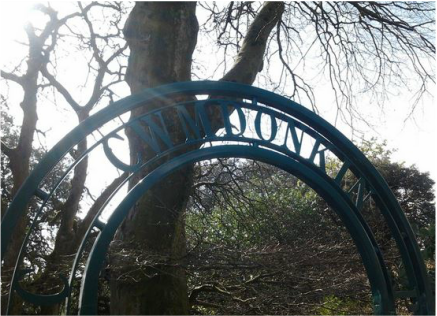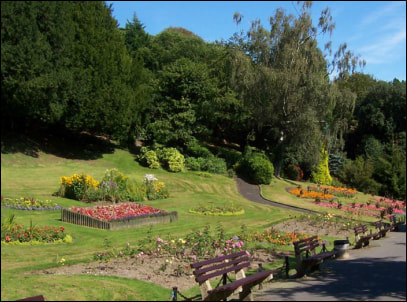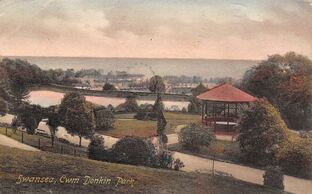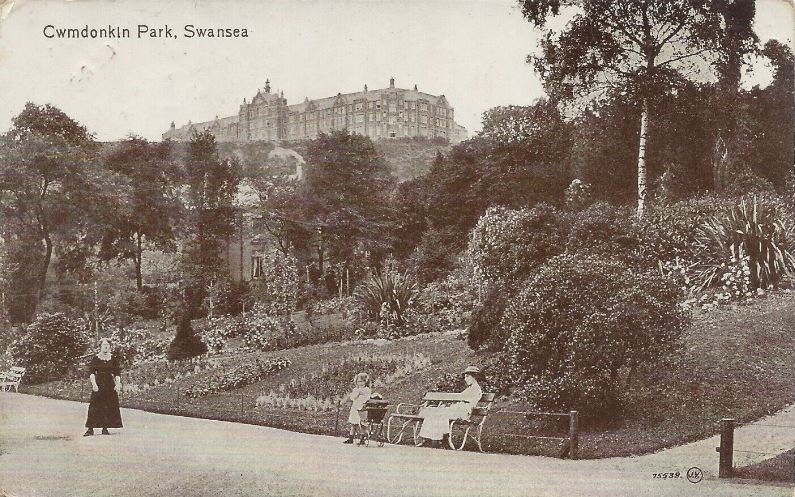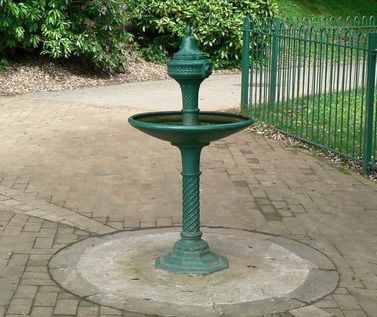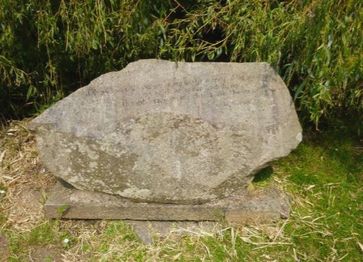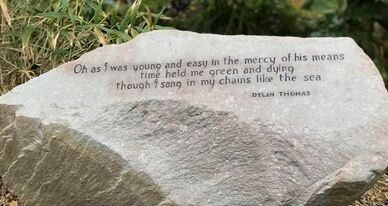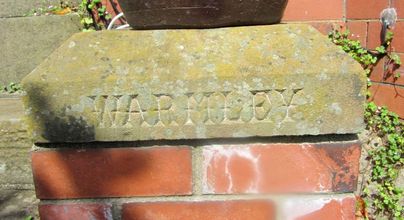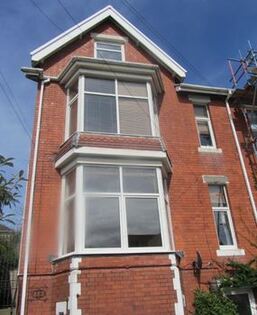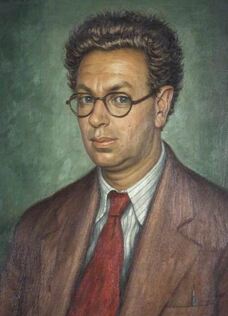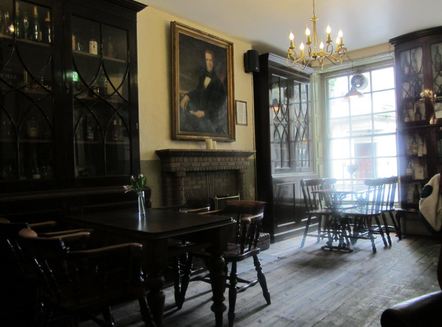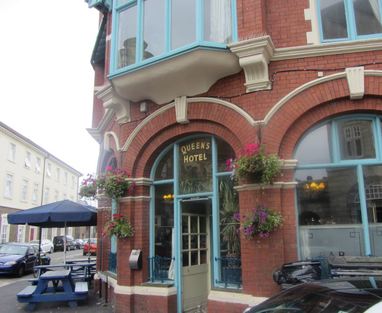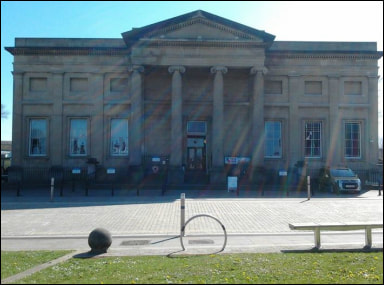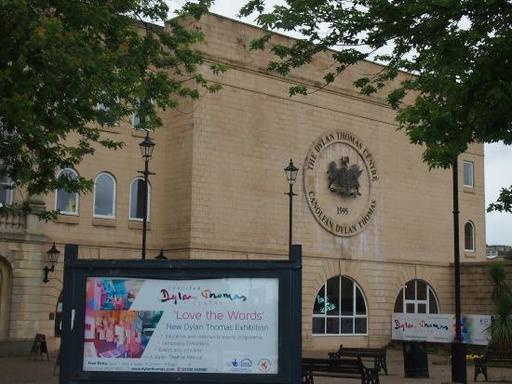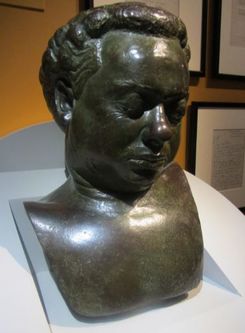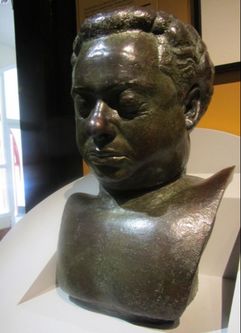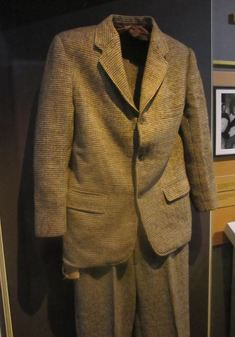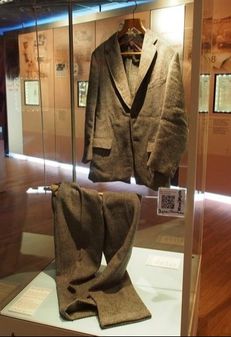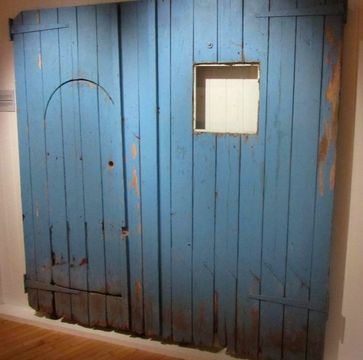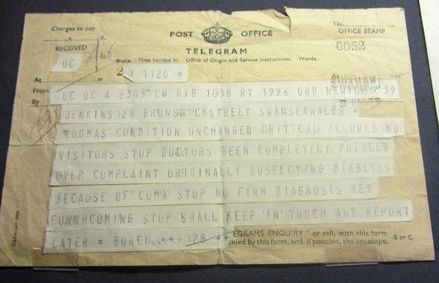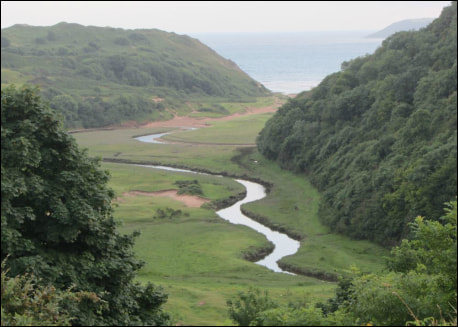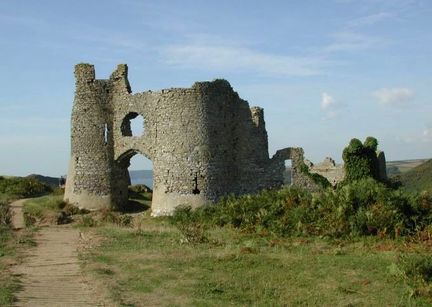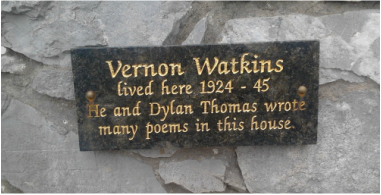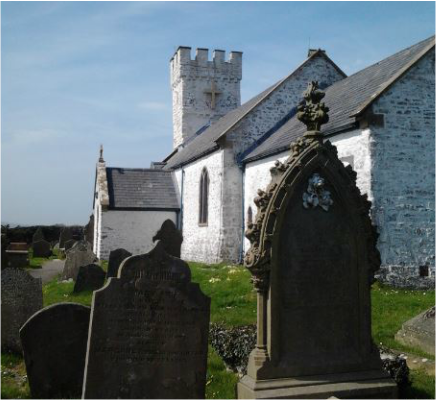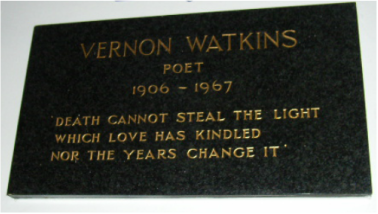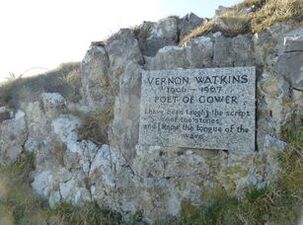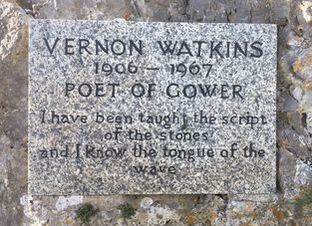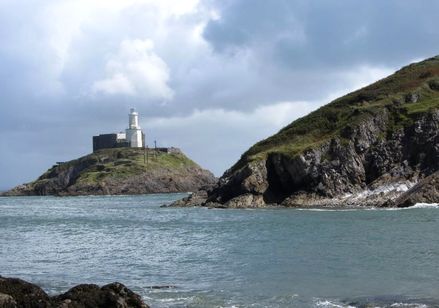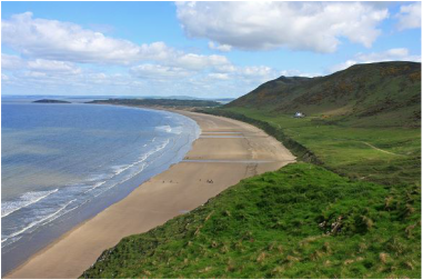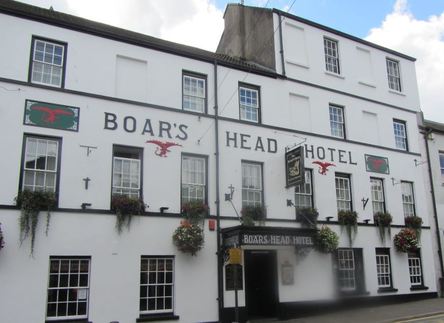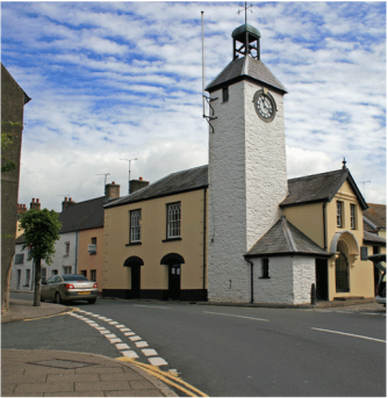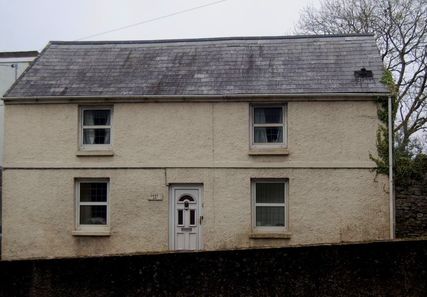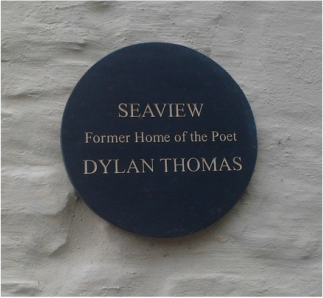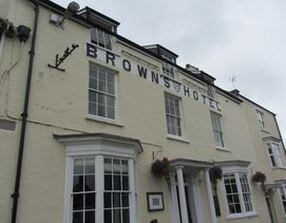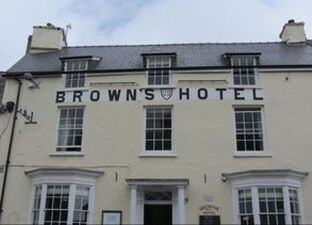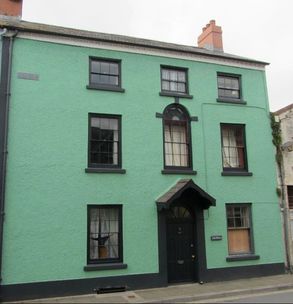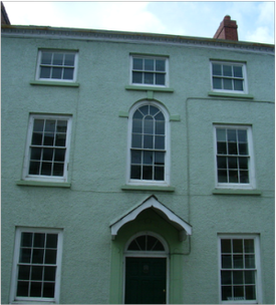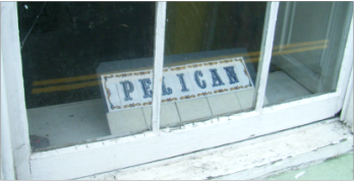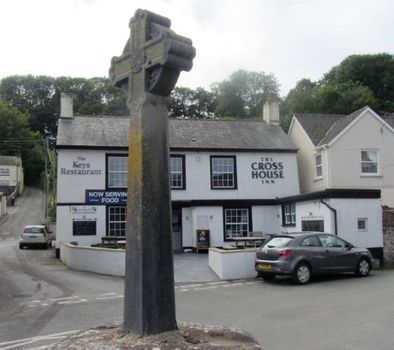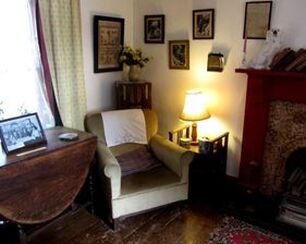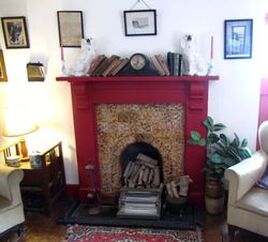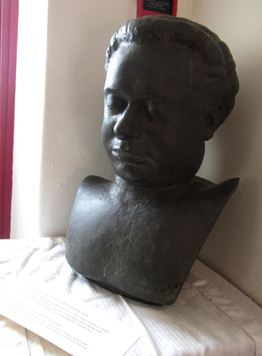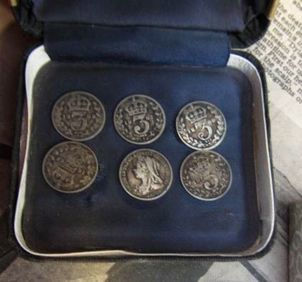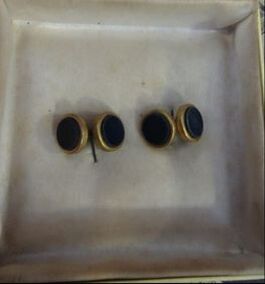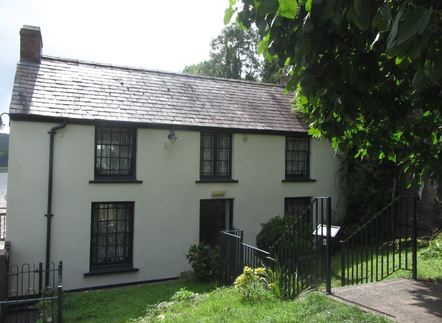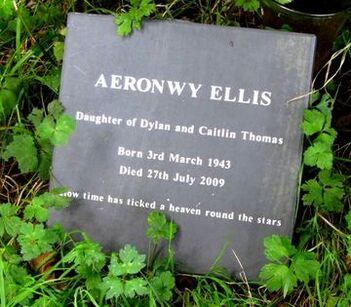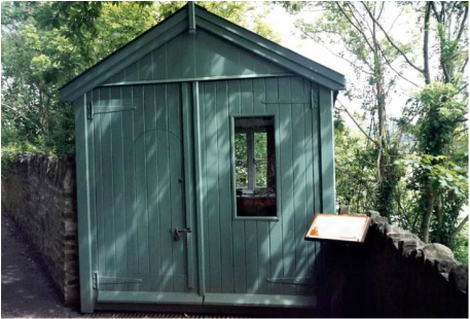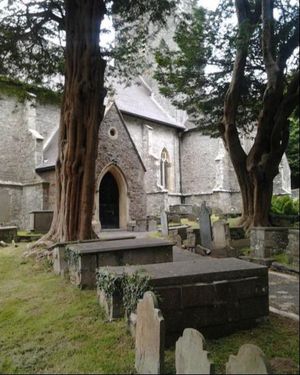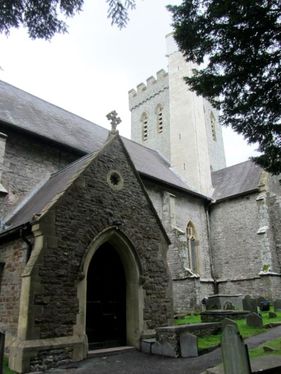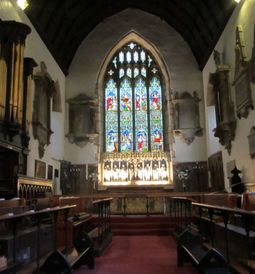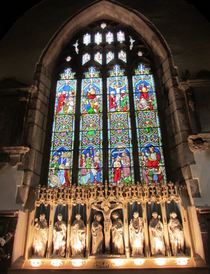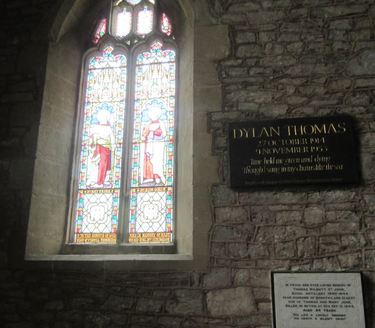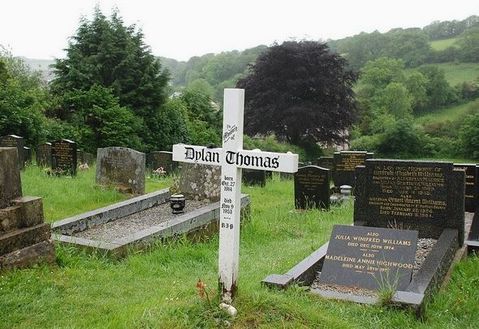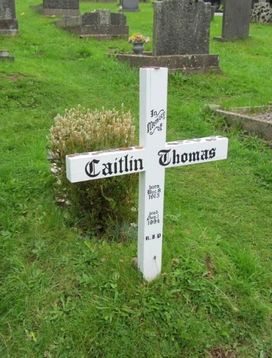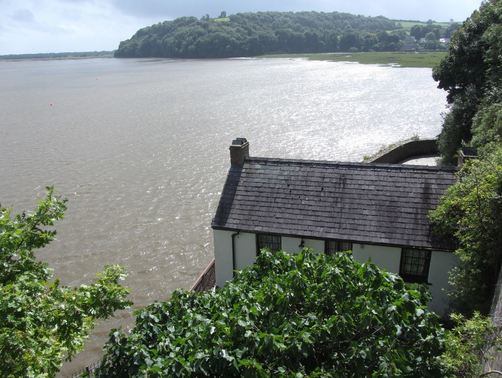Swansea, Cwmdonkin Park and The Uplands
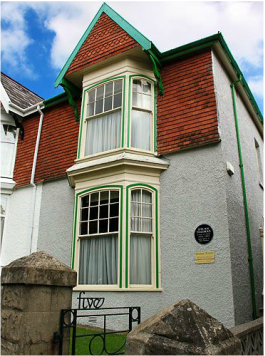
5 Cwmdonkin Drive, The Uplands, Swansea
On the 27th of October, 1914, in the upstairs front bedroom of this modest Edwardian family home, located on Cwmdonkin Drive, Uplands, Swansea, Dylan Marlais Thomas made his entrance into the world.
Built in 1913 by Swansea-based builder W.H. Harding, it was one of six houses, (three pairs of semi-detached suburban villas), approved for development by the Borough of Swansea in 1908.
Overlooking the majestic Cwmdonkin Park and the sweeping shoreline of Swansea Bay, the house appears in many of Dylan Thomas's poems, stories, letters and broadcasts, most notably in the short stories contained in his 1940 prose collection entitled, 'Portrait Of The Artist As A Young Dog'.
Deceptively larger than the outside would suggest, the house has been beautifully restored by the owner, Geoff Haden, to how it would have appeared in 1914, and is now open to visit, by appointment, all year round.
The marvellous website for the Dylan Thomas Birthplace can be found on the 'Links' page of this website.
On the 27th of October, 1914, in the upstairs front bedroom of this modest Edwardian family home, located on Cwmdonkin Drive, Uplands, Swansea, Dylan Marlais Thomas made his entrance into the world.
Built in 1913 by Swansea-based builder W.H. Harding, it was one of six houses, (three pairs of semi-detached suburban villas), approved for development by the Borough of Swansea in 1908.
Overlooking the majestic Cwmdonkin Park and the sweeping shoreline of Swansea Bay, the house appears in many of Dylan Thomas's poems, stories, letters and broadcasts, most notably in the short stories contained in his 1940 prose collection entitled, 'Portrait Of The Artist As A Young Dog'.
Deceptively larger than the outside would suggest, the house has been beautifully restored by the owner, Geoff Haden, to how it would have appeared in 1914, and is now open to visit, by appointment, all year round.
The marvellous website for the Dylan Thomas Birthplace can be found on the 'Links' page of this website.
Pictured above are the gates to Cwmdonkin Park. Located just across the road from Dylan Thomas's birthplace and clearly visible from the front bedroom, lie the stunningly beautiful, manicured gardens of Cwmdonkin Park. The park features heavily in the writing of Dylan Thomas, most notably in the short autobiographical story 'Patricia, Edith And Arnold', from the delightful collection of short stories published as 'Portrait Of The Artist As A Young Dog' in 1940, but it is his haunting poem, 'Hunchback In The Park' for which it is best known.
Cwmdonkin Park, with it's middle-class bandstand, tennis courts, bowling green and reservoir, was opened on the 24th of July, 1874 to adverse criticism from some residents of Swansea who complained that it was built in what was essentially one of the more affluent areas of the town. The controversy over the spending of public funds on Cwmdonkin Park led to the establishment of the 'Open Spaces Movement', which campaigned for more parks to be built in the more deprived, working-class areas of the town.
Dylan Thomas however, loved the park, and in nostalgic moments wrote about it fondly, in broadcasts such as 'Return Journey' and 'Reminiscences Of Childhood'...."A world within the world of the sea town, full of terrors and treasures, a country just born and always changing".
Cwmdonkin Park also features in the closing lines in one of Dylan Thomas's most beautiful poems, 'Should Lanterns Shine'..."The ball I threw while playing in the park has not yet reached the ground."
Cwmdonkin Park, with it's middle-class bandstand, tennis courts, bowling green and reservoir, was opened on the 24th of July, 1874 to adverse criticism from some residents of Swansea who complained that it was built in what was essentially one of the more affluent areas of the town. The controversy over the spending of public funds on Cwmdonkin Park led to the establishment of the 'Open Spaces Movement', which campaigned for more parks to be built in the more deprived, working-class areas of the town.
Dylan Thomas however, loved the park, and in nostalgic moments wrote about it fondly, in broadcasts such as 'Return Journey' and 'Reminiscences Of Childhood'...."A world within the world of the sea town, full of terrors and treasures, a country just born and always changing".
Cwmdonkin Park also features in the closing lines in one of Dylan Thomas's most beautiful poems, 'Should Lanterns Shine'..."The ball I threw while playing in the park has not yet reached the ground."
A photograph of the flower-beds in Cwmdonkin Park, located beside Dylan's drinking fountain. The photograph was taken in July 2014, the year which marked the Centenary of the poet's birth.
Two wonderful real-photographic vintage postcards of Cwmdonkin Park dating from 1910.This is how the park, complete with Bandstand, who have looked to the young Dylan Thomas during his childhood.
Portrait of John Smallcombe, Cwmdonkin Park Keeper, Circa 1900
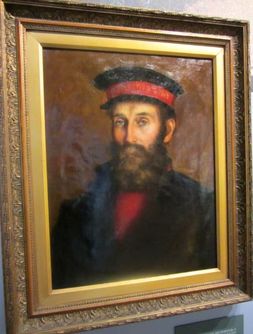
Housed in the Dylan Thomas Centre, located in Somerset Place, Swansea, is this wonderfully executed portrait of the first Park-Keeper at Cwmdonkin Park, John Smallcombe.
Painted in oils on canvas the portrait depicts John Smallcombe attired in his high ranking Salvation Army uniform.
Cwmdonkin Park features heavily in the writings of Dylan Thomas, both in his poetry and his prose, and, although sometimes not mentioned by name, the park he refers to is instantly recognisable as Cwmdonkin.
John Smallcombe, 'Old Smally' as Dylan and his friends called him, is also mentioned at times, most notably in the poem, 'Hunchback in the Park'..."Dodging the Park-Keeper with his stick that picked up leaves."
But it is the B.B.C. Home Service radio broadcast on the 15th of June, 1947 entitled 'Return Journey' which brings John Smallcombe to life, giving his a voice.
In the broadcast, a mature Dylan Thomas searches the streets and places of his Swansea childhood searching for his younger self. At the end of the piece he returns to Cwmdonkin Park and confronts the Park- Keeper asking if he remembers the small boy and his friends who used to taunt him all those years ago. The Park-Keeper replies;
"Oh yes, yes, I knew him well. He used to climb the reservoir railings and pelt the old swans. Run like a billy-goat over the grass you should keep off of. Cut branches off the trees. Carve words on the benches. Pull up moss in the rockery, go ship through the dahlias. Fight in the bandstand. Climb the elms and moon up the top like an owl. Light fires in the bushes. Play on the green bank. Oh yes, I knew him well. I think he was happy all the time. I've known him by the thousands".
The last line of the broadcast is spoken by the Park-Keeper. When Dylan, as narrator, asks the Park-Keeper what has become of the young Dylan Thomas, the Park-Keeper replies, along with the toll of his park bell, rather prophetically,
"Dead. Dead...Dead...Dead...Dead...Dead...Dead."
Painted in oils on canvas the portrait depicts John Smallcombe attired in his high ranking Salvation Army uniform.
Cwmdonkin Park features heavily in the writings of Dylan Thomas, both in his poetry and his prose, and, although sometimes not mentioned by name, the park he refers to is instantly recognisable as Cwmdonkin.
John Smallcombe, 'Old Smally' as Dylan and his friends called him, is also mentioned at times, most notably in the poem, 'Hunchback in the Park'..."Dodging the Park-Keeper with his stick that picked up leaves."
But it is the B.B.C. Home Service radio broadcast on the 15th of June, 1947 entitled 'Return Journey' which brings John Smallcombe to life, giving his a voice.
In the broadcast, a mature Dylan Thomas searches the streets and places of his Swansea childhood searching for his younger self. At the end of the piece he returns to Cwmdonkin Park and confronts the Park- Keeper asking if he remembers the small boy and his friends who used to taunt him all those years ago. The Park-Keeper replies;
"Oh yes, yes, I knew him well. He used to climb the reservoir railings and pelt the old swans. Run like a billy-goat over the grass you should keep off of. Cut branches off the trees. Carve words on the benches. Pull up moss in the rockery, go ship through the dahlias. Fight in the bandstand. Climb the elms and moon up the top like an owl. Light fires in the bushes. Play on the green bank. Oh yes, I knew him well. I think he was happy all the time. I've known him by the thousands".
The last line of the broadcast is spoken by the Park-Keeper. When Dylan, as narrator, asks the Park-Keeper what has become of the young Dylan Thomas, the Park-Keeper replies, along with the toll of his park bell, rather prophetically,
"Dead. Dead...Dead...Dead...Dead...Dead...Dead."
The Water Fountain, Cwmdonkin Park, The Uplands, Swansea
Although many of the features of Cwmdonkin Park have long since disappeared since the time when Dylan Thomas was a young boy, including landmarks such as the bandstand and the reservoir, what does remain is the original and iconic Edwardian cast-iron drinking fountain, immortalised by Dylan Thomas in his early nostalgic poem 'The Hunchback In The Park' in which includes the famous line;
"Drinking water from the chained cup that the children filled with gravel in the fountain basin where I sailed my ship."
"Drinking water from the chained cup that the children filled with gravel in the fountain basin where I sailed my ship."
The Dylan Thomas Memorial Stone, Cwmdonkin Park, The Uplands, Swansea
In 1963, to mark the tenth anniversary of Dylan Thomas's passing, the two ladies Barbara Holdridge and Marianne Roney, who had founded Caedmon Records in America and who had single-handedly created the Literary audio-book genre, sent Vernon Watkins a cheque for fifty pounds in order for him to commission a permanent memorial to Dylan Thomas in the park which he loved and had made so famous.
Carved in Welsh sandstone by artist Ronald Cour, but now sadly rather weather-worn, the stone features the last three lines of Dylan Thomas's most famous poem, 'Fern Hill'.
"Oh as I was young and easy in the mercy of his means, time held me green and dying though I sang in my chains like the sea".
Carved in Welsh sandstone by artist Ronald Cour, but now sadly rather weather-worn, the stone features the last three lines of Dylan Thomas's most famous poem, 'Fern Hill'.
"Oh as I was young and easy in the mercy of his means, time held me green and dying though I sang in my chains like the sea".
Update...On the 9th of November 2018, the sixty-fifth anniversary of the death of Dylan Thomas, the newly restored Cwmdonkin Park memorial stone was unveiled.
In an intimate service, attended by around thirty people, the stone was unveiled by Glenys Cour, widow of the original sculptor, Ronald Cour.
The inscription on the stone had become damaged due to years of moss damage and erosion so restoration had been desperately needed which was generously paid for by the Dylan Thomas Society, the Lottery Heritage Fund, the Dylan Thomas Birthplace and the Friends of Cwmdonkin Park.
In an intimate service, attended by around thirty people, the stone was unveiled by Glenys Cour, widow of the original sculptor, Ronald Cour.
The inscription on the stone had become damaged due to years of moss damage and erosion so restoration had been desperately needed which was generously paid for by the Dylan Thomas Society, the Lottery Heritage Fund, the Dylan Thomas Birthplace and the Friends of Cwmdonkin Park.
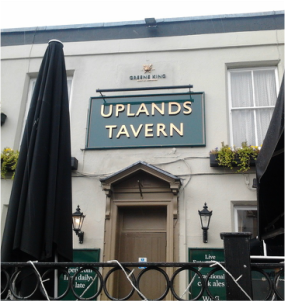
The Uplands Tavern, Uplands Square, Swansea
Located in Uplands Square, just a short distance from the steep hill which runs from Dylan Thomas's childhood home, is The Uplands Tavern, which at the time that the Thomas family lived in Cwmdonkin Drive was known as the Uplands Hotel.
This is the public house which is considered to be Dylan Thomas's first 'Local' and where he discovered what was to become his life-long love of beer. As he wrote...
"I liked the taste of beer, it's live white lather, it's brass-bright depths, the sudden world through the wet brown walls of the glass, the tilted rush to the lips and the slow swallowing down to the lapping belly, the salt on the tongue, the foam at the corners..."
Dylan's father, D.J. Thomas, was also known to like the odd pint or two, although this was largely kept quiet amongst the family and the other teachers at the Swansea Grammar School where he was senior English Master.
Dylan Thomas's father was however well known at The Uplands Tavern, where he was nicknamed 'The Professor', and on Wednesday afternoons, the Grammar school's half-day, he would often be found in the company of a fellow master, W. S. 'Soapy' Davies, who seemed to be the only other teacher at the Grammar school who could tolerate D.J'.s irascible ways. Also often in the evenings, especially if Florence Thomas had invited relatives or friends to call round to 5 Cwmdonkin Drive, D.J. would escape from his study at the rear of the house, through the French windows, down the path to the gate at the bottom of the garden and make his way to the Uplands Tavern. Dylan's sister, Nancy, was to later recall that her father's temper could be gauged by the redness of his cheeks on his return from Uplands Square.
Located in Uplands Square, just a short distance from the steep hill which runs from Dylan Thomas's childhood home, is The Uplands Tavern, which at the time that the Thomas family lived in Cwmdonkin Drive was known as the Uplands Hotel.
This is the public house which is considered to be Dylan Thomas's first 'Local' and where he discovered what was to become his life-long love of beer. As he wrote...
"I liked the taste of beer, it's live white lather, it's brass-bright depths, the sudden world through the wet brown walls of the glass, the tilted rush to the lips and the slow swallowing down to the lapping belly, the salt on the tongue, the foam at the corners..."
Dylan's father, D.J. Thomas, was also known to like the odd pint or two, although this was largely kept quiet amongst the family and the other teachers at the Swansea Grammar School where he was senior English Master.
Dylan Thomas's father was however well known at The Uplands Tavern, where he was nicknamed 'The Professor', and on Wednesday afternoons, the Grammar school's half-day, he would often be found in the company of a fellow master, W. S. 'Soapy' Davies, who seemed to be the only other teacher at the Grammar school who could tolerate D.J'.s irascible ways. Also often in the evenings, especially if Florence Thomas had invited relatives or friends to call round to 5 Cwmdonkin Drive, D.J. would escape from his study at the rear of the house, through the French windows, down the path to the gate at the bottom of the garden and make his way to the Uplands Tavern. Dylan's sister, Nancy, was to later recall that her father's temper could be gauged by the redness of his cheeks on his return from Uplands Square.
'Warmley' Eversley Road, Sketty, Swansea
Located at number thirty-eight Eversley Road, Sketty, a short distance from Cwmdonkin Drive, is the childhood home of Dylan Thomas's friend, the composer Daniel Jones.
A photograph of Daniel Jones' childhood home, 'Warmley', captured in 2016 and an image of the wonderful oil painting of Daniel Jones painted by Alfred Janes in 1947. The portrait now hangs in the National Museum of Wales, Cardiff.
Daniel Jenkyn Jones was born in Pembroke, South Wales, on the 7th of December, 1912. He was born into a very musical family, his father, Jenkyn Jones, a bank manager, was himself a composer and church organist and his mother had previously had a career as a singer. A talented pianist himself, by the time he was just nine years old Daniel Jones had already composed several piano sonatas.
Daniel Jones first met Dylan Thomas in 1925 at the Swansea Grammar School and their mutual love of the arts led to a close friendship which would last until the poet's death in 1953.
After studying English Literature at Swansea University, their friendship was cemented when they became part of a group known as 'The Kardomah Boys', and informal circle of artists, writers and musicians who met daily at the Kardomah Cafe in Swansea. The group also included Vernon Watkins and the painter Fred Janes.
Moving to London in 1935 he attended the Royal Academy of Music after gaining the Mendlessohn Scholarship. He graduated in 1938.
At the outbreak of war in 1939, Daniel Jones was enlisted into the Intelligence Corps and spent the war at Bletchley Park as a cryptographer and code-breaker due to his linguistic skills and understanding of Russian, German and Japanese.
After the war, due to his passion and dedication to music, Daniel Jones began to become recognised as a talented and innovative composer. In 1950 his composition, 'Symphonic Prologue' won first prize at the Royal Philharmonic Society. Following this, most of his compositions were written to commission, from event organisers and institutions such as The Festival of Britain, The Swansea Festival, The Royal National Eisteddfod, the B.B.C. and the Royal Philharmonic Orchestra. Between the years 1945 and 1985 he composed a series of twelve symphonies and eight string quartets as well as other works including a cantata entitled 'The Country Beyond The Stars' a musical setting to a poem by Henry Vaughn.
Daniel Jones composed the musical scores for the songs, 'Johnny Crack and Flossie Snail', 'The Children's Game', 'Polly Garter's Song' and 'Mr. Waldo's Song' which appeared in the posthumous 1954 publication of Dylan Thomas's 'Under Milk Wood', published by J.M. Dent and Sons. The same year he dedicated his Fourth Symphony to his friend's memory as well as being involved in the editing posthumous editions of Dylan's collected poetry and prose.
In 1977 he published his own volume of memoirs entitled, 'My Friend Dylan Thomas', a copy of which is held in the Richard Burton Museum's Dylan Thomas Collection.
In 1968, Daniel Jones was awarded the Order of the British Empire for services to music.
Daniel Jones died on the 23rd of April, 1993 at his home in Swansea, he was eighty years of age.
Daniel Jones first met Dylan Thomas in 1925 at the Swansea Grammar School and their mutual love of the arts led to a close friendship which would last until the poet's death in 1953.
After studying English Literature at Swansea University, their friendship was cemented when they became part of a group known as 'The Kardomah Boys', and informal circle of artists, writers and musicians who met daily at the Kardomah Cafe in Swansea. The group also included Vernon Watkins and the painter Fred Janes.
Moving to London in 1935 he attended the Royal Academy of Music after gaining the Mendlessohn Scholarship. He graduated in 1938.
At the outbreak of war in 1939, Daniel Jones was enlisted into the Intelligence Corps and spent the war at Bletchley Park as a cryptographer and code-breaker due to his linguistic skills and understanding of Russian, German and Japanese.
After the war, due to his passion and dedication to music, Daniel Jones began to become recognised as a talented and innovative composer. In 1950 his composition, 'Symphonic Prologue' won first prize at the Royal Philharmonic Society. Following this, most of his compositions were written to commission, from event organisers and institutions such as The Festival of Britain, The Swansea Festival, The Royal National Eisteddfod, the B.B.C. and the Royal Philharmonic Orchestra. Between the years 1945 and 1985 he composed a series of twelve symphonies and eight string quartets as well as other works including a cantata entitled 'The Country Beyond The Stars' a musical setting to a poem by Henry Vaughn.
Daniel Jones composed the musical scores for the songs, 'Johnny Crack and Flossie Snail', 'The Children's Game', 'Polly Garter's Song' and 'Mr. Waldo's Song' which appeared in the posthumous 1954 publication of Dylan Thomas's 'Under Milk Wood', published by J.M. Dent and Sons. The same year he dedicated his Fourth Symphony to his friend's memory as well as being involved in the editing posthumous editions of Dylan's collected poetry and prose.
In 1977 he published his own volume of memoirs entitled, 'My Friend Dylan Thomas', a copy of which is held in the Richard Burton Museum's Dylan Thomas Collection.
In 1968, Daniel Jones was awarded the Order of the British Empire for services to music.
Daniel Jones died on the 23rd of April, 1993 at his home in Swansea, he was eighty years of age.
'The No Sign Bar' Wind Street, Swansea
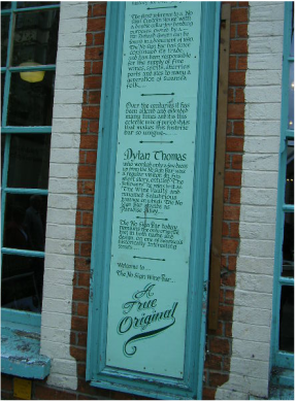
Telling the history of 'The No Sign Bar', this elegant and beautifully hand-painted wall-plaque reads, in its entirety;
"No Sign Bar, No.56 Wind St.
Wind Street is said to have derived it's unusual name from being a street of wine merchants. It is therefore no surprise to discover that 'The No Sign Wine Bar' has played it's part in the streets history for over 300 years.
The first reference to a 'No Sign Custom House' with a double cellar for bonding purposes, owned by a Mr. Richard Gwynn can be found in a document of 1690.The No Sign Bar has since continued its trade and has been responsible for the supply of fine wines, spirits, sherries, ports and ales to many a generation of Swansea folk.
Over the centuries it has been altered and extended many times and it is this eclectic mix of period styles that makes this historic bar so unique.
Dylan Thomas, who worked only a few doors up from the 'No Sign Bar' was a regular visitor. In his short story 'The Followers' he refers to it as 'The Wine Vaults' and renamed Salubrious Passage, on which 'The No Sign Bar' stands, as 'Paradise Alley'
The No Sign Bar today remains the only original bar in both name and design on one of Swansea's historically interesting streets. Welcome to 'The No Sign Bar' A true original...
"No Sign Bar, No.56 Wind St.
Wind Street is said to have derived it's unusual name from being a street of wine merchants. It is therefore no surprise to discover that 'The No Sign Wine Bar' has played it's part in the streets history for over 300 years.
The first reference to a 'No Sign Custom House' with a double cellar for bonding purposes, owned by a Mr. Richard Gwynn can be found in a document of 1690.The No Sign Bar has since continued its trade and has been responsible for the supply of fine wines, spirits, sherries, ports and ales to many a generation of Swansea folk.
Over the centuries it has been altered and extended many times and it is this eclectic mix of period styles that makes this historic bar so unique.
Dylan Thomas, who worked only a few doors up from the 'No Sign Bar' was a regular visitor. In his short story 'The Followers' he refers to it as 'The Wine Vaults' and renamed Salubrious Passage, on which 'The No Sign Bar' stands, as 'Paradise Alley'
The No Sign Bar today remains the only original bar in both name and design on one of Swansea's historically interesting streets. Welcome to 'The No Sign Bar' A true original...
The 'No Sign Bar', run by the Swansea wine-dealing family the Munday's, has been established in Swansea's famous Wind Street for well over 300 years. The first documented reference, dating from the late 1600's, has it referred to as a 'no-custom house' and it would appear the building has always been a licensed premises of one kind of another since it was built. It possibly acquired it's unusual name from being overlooked when licensing laws were introduced when each Public House was required to display some form of sign on it's frontage, or possibly because 'Number 56', as it was previously known, was considered to be just a bar instead of a Public House and had no need to display the enforced sign. When the mistake was discovered however, local historians have surmised that this was the time that the 'No Sign Bar' adopted its peculiar name.
The 'No Sign Bar', even in Dylan Thomas's time, had the air of antiquity surrounding it, with it's interior having being furnished in somewhat of a 'museum style', with wine memorabilia, Victorian oil paintings of dour old gentlemen, cabinets stacked with vintage wine bottles and wine-trade posters of auctions and advertising. During Dylan Thomas's time beer was not sold on the premises.
Despite no beer being served, which Dylan Thomas only drank in those early days, it would appear that he was a regular visitor to the 'No Sign Bar', being conveniently located just a few doors down from the offices of 'The Daily Post' where he was employed as a junior reporter.
The 'No Sign Bar', even in Dylan Thomas's time, had the air of antiquity surrounding it, with it's interior having being furnished in somewhat of a 'museum style', with wine memorabilia, Victorian oil paintings of dour old gentlemen, cabinets stacked with vintage wine bottles and wine-trade posters of auctions and advertising. During Dylan Thomas's time beer was not sold on the premises.
Despite no beer being served, which Dylan Thomas only drank in those early days, it would appear that he was a regular visitor to the 'No Sign Bar', being conveniently located just a few doors down from the offices of 'The Daily Post' where he was employed as a junior reporter.
The original street sign for 'Salubrious Passage', the short covered walkway which runs alongside 'The No Sign Bar'. Dylan Thomas used the pub and the passageway as backdrops in his short ghost story, 'The Followers', although he changed the names to 'Paradise Alley' and 'The Vaults'. It was certainly Dylan Thomas feeling nostalgic for his old Swansea days as 'The Followers' wasn't written until the last year of his life. Sadly, as of 2014, the original sign is no longer in place.
The Queens Hotel, Cambrian Place, The Maritime Quarter, Swansea
Swansea Museum, Victoria Road, Swansea
Built for The Royal Institution For South Wales in 1841, Swansea Museum is the oldest museum in Wales, or as Dylan Thomas so eloquently phrased it in his 1943 B.B.C. Welsh Home Service broadcast, 'Reminiscences Of Childhood'..."The museum that should have BEEN in a museum".
This Grade-2, neoclassical style building was commissioned by a group of art and science enthusiasts to house the Royal Institution's many and varied collections as well as to provide a venue for research and learning facilities for the people of Swansea and South Wales.
Located on the Oystermouth Road, just across from Wind Street and close to The Dylan Thomas Centre, Swansea Museum features many fascinating permanent collections which include exhibitions charting Swansea's history through both World Wars, fossils, taxidermy, natural history and relics, an Egyptian Mummy and artifacts found in and around Swansea, Mumbles, Gower and the surrounding areas. Many Dylan Thomas events and exhibitions have also been housed and have taken place here.
This Grade-2, neoclassical style building was commissioned by a group of art and science enthusiasts to house the Royal Institution's many and varied collections as well as to provide a venue for research and learning facilities for the people of Swansea and South Wales.
Located on the Oystermouth Road, just across from Wind Street and close to The Dylan Thomas Centre, Swansea Museum features many fascinating permanent collections which include exhibitions charting Swansea's history through both World Wars, fossils, taxidermy, natural history and relics, an Egyptian Mummy and artifacts found in and around Swansea, Mumbles, Gower and the surrounding areas. Many Dylan Thomas events and exhibitions have also been housed and have taken place here.
The Dylan Thomas Centre, Somerset Place, Swansea
Located in Somerset Place, in the heart of the Maritime Quarter of Swansea, is the magnificent Dylan Thomas Centre. The building, previously the Swansea Guildhall which was completed in 1825, is now an Arts Centre housing a permanent Dylan Thomas exhibition. The exhibition itself has gone through various incarnations, but at the present time is named, so perfectly aptly, 'Love The Words'.
The building was chosen to host the 1995 U.K. Year of Literature and Writing and fittingly during the celebrations The Dylan Thomas Centre was officially opened by Dylan Thomas enthusiast and former President of the United States, Jimmy Carter.
The Dylan Thomas Centre is home to an interactive exhibition entitled 'Love The Words', which is based around the immense collection of Dylan Thomas ephemera and memorabilia, mostly owned by Jeff Towns, a great friend of The Richard Burton Online Museum. The exhibition takes the visitor on a trail through Dylan Thomas's life and work with the visual aids of letters, manuscripts, photographs and worksheets. The new exhibition was launched on what would have been Dylan Thomas's !00th birthday, the 27th of October, 2014.
The Dylan Thomas Centre also hosts a variety of events throughout the year mainly focusing on poetry, the arts, culture, literature and science and can be viewed and contacted via the 'Links' page of this website.
The building was chosen to host the 1995 U.K. Year of Literature and Writing and fittingly during the celebrations The Dylan Thomas Centre was officially opened by Dylan Thomas enthusiast and former President of the United States, Jimmy Carter.
The Dylan Thomas Centre is home to an interactive exhibition entitled 'Love The Words', which is based around the immense collection of Dylan Thomas ephemera and memorabilia, mostly owned by Jeff Towns, a great friend of The Richard Burton Online Museum. The exhibition takes the visitor on a trail through Dylan Thomas's life and work with the visual aids of letters, manuscripts, photographs and worksheets. The new exhibition was launched on what would have been Dylan Thomas's !00th birthday, the 27th of October, 2014.
The Dylan Thomas Centre also hosts a variety of events throughout the year mainly focusing on poetry, the arts, culture, literature and science and can be viewed and contacted via the 'Links' page of this website.
The Death-Mask of Dylan Thomas, Cast By The Sculptor David Slivka, November 1953
The photograph shown here is of Dylan Thomas's death mask which is on permanent display in the entrance hall of The Dylan Thomas Centre.
On the 11th of November 1953, accompanied by his assistant Ibram Lassaw, the American artist and sculptor David Slivka entered the mortuary of St. Vincent's Hospital in New York to cast the death mask of his friend, Dylan Thomas, who had died just two days previously. From this plaster-cast five bronze busts were produced. Two now reside in America, one in the Poetry Center in New York, where Dylan Thomas first performed 'Under Milk Wood' and the other, in the Southern Illinois University. The other three are now in back in Wales. The one pictured was presented to The Dylan Thomas Centre in 2005 by David Slivka himself and another is on display in the National Museum Of Wales, Cardiff. The final bust, which had been previously owned by Richard Burton, now sits proudly at The Boathouse, Laugharne.
On the 11th of November 1953, accompanied by his assistant Ibram Lassaw, the American artist and sculptor David Slivka entered the mortuary of St. Vincent's Hospital in New York to cast the death mask of his friend, Dylan Thomas, who had died just two days previously. From this plaster-cast five bronze busts were produced. Two now reside in America, one in the Poetry Center in New York, where Dylan Thomas first performed 'Under Milk Wood' and the other, in the Southern Illinois University. The other three are now in back in Wales. The one pictured was presented to The Dylan Thomas Centre in 2005 by David Slivka himself and another is on display in the National Museum Of Wales, Cardiff. The final bust, which had been previously owned by Richard Burton, now sits proudly at The Boathouse, Laugharne.
The David Slivka Bronze Sculpture of Dylan Thomas Presentation Programme
The Poetry Centre of the YM - YWHA, Lexington Avenue New York, May 1964
The Poetry Centre of the YM - YWHA, Lexington Avenue New York, May 1964
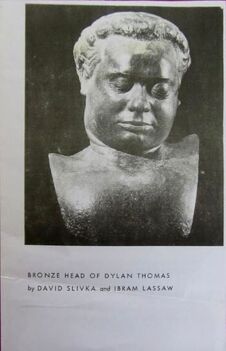
Held in the Richard Burton Museum Collection is this rare programme for the Presentation Ceremony of the bronze 'Death-Mask' of Dylan Thomas to the National Museum of Wales.
The event took place at the Poetry Centre of the YM - YMHA, based on 92nd Street and Lexington Avenue, New York on Sunday May the 24th, 1964.
The event was organised and presided over by Richard Burton's foster-father, Philip Burton, who was the Director of the American Musical and Dramatic Academy at the time. All the proceeds from the event were donated to the Dylan Thomas Fund and to the Fund for Younger Poets of the Poetry Centre of the YM - YWHA, the fund which had previously made it possible to bring Dylan Thomas over to America for his first lecture tour in 1950.
Alongside Richard Burton, who was in attendance to accept the bronze sculpture on behalf of the National Museum of Wales, were the sculptor himself, David Slivka, American artist Paul Jenkins who was to donate the sculpture, John Malcolm Brinnin and Nancy Wickwire who had performed alongside Dylan Thomas in the Poetry Centre production of 'Under Milk Wood' on May the 14th, 1953.
On the reverse of the programme, David Slivka has added his 'Footnotes on the Death Mask' which reads;
"The making of a 'Death-Mask' or 'Head of Dylan' is surrounded by a deeper significance than the concern for preserving a moment of his physical presence in death. Our returning of this bronze replica to his people becomes only a humble token of love, where it is not possible to measure the magnitude of meaning that Dylan has left with us by his living presence and art. As three American artists, we would like to believe that we are in a small way privileged to speak for all American artists who cannot find an adequacy, through words of tribute, to express what Dylan has meant in our lives and in our time.
As a sculptor, I know the beauty of that head. As a friend who had been enriched by his words and thought, and had given in return, then to be faced with the long silence - I felt the need - to give of myself, to hold that physical memory of Dylan for myself, and others, it seemed, then, all that was left, and yet knowing that no memory or eternity in death's sleeping image would ever achieve the monumentality of Dylan's sculptured words and imagery, left by that voice and hand.
I decided to enlist the help of the sculptor, Ibram Lassaw, a friend, who felt as I did about the importance of making the mask. It was our successful collaboration that made this event possible. To recount the entire story of the making of the 'Death-Mask', with all the deeply moving, macabre, amusing, and ironic aspects, would be a tale that only Dylan could have done justice to - and enjoyed telling on himself.
Who knows but that Dylan might have been moved to write an 'Elegy for a Sculptor' if our roles had been reversed."
The event took place at the Poetry Centre of the YM - YMHA, based on 92nd Street and Lexington Avenue, New York on Sunday May the 24th, 1964.
The event was organised and presided over by Richard Burton's foster-father, Philip Burton, who was the Director of the American Musical and Dramatic Academy at the time. All the proceeds from the event were donated to the Dylan Thomas Fund and to the Fund for Younger Poets of the Poetry Centre of the YM - YWHA, the fund which had previously made it possible to bring Dylan Thomas over to America for his first lecture tour in 1950.
Alongside Richard Burton, who was in attendance to accept the bronze sculpture on behalf of the National Museum of Wales, were the sculptor himself, David Slivka, American artist Paul Jenkins who was to donate the sculpture, John Malcolm Brinnin and Nancy Wickwire who had performed alongside Dylan Thomas in the Poetry Centre production of 'Under Milk Wood' on May the 14th, 1953.
On the reverse of the programme, David Slivka has added his 'Footnotes on the Death Mask' which reads;
"The making of a 'Death-Mask' or 'Head of Dylan' is surrounded by a deeper significance than the concern for preserving a moment of his physical presence in death. Our returning of this bronze replica to his people becomes only a humble token of love, where it is not possible to measure the magnitude of meaning that Dylan has left with us by his living presence and art. As three American artists, we would like to believe that we are in a small way privileged to speak for all American artists who cannot find an adequacy, through words of tribute, to express what Dylan has meant in our lives and in our time.
As a sculptor, I know the beauty of that head. As a friend who had been enriched by his words and thought, and had given in return, then to be faced with the long silence - I felt the need - to give of myself, to hold that physical memory of Dylan for myself, and others, it seemed, then, all that was left, and yet knowing that no memory or eternity in death's sleeping image would ever achieve the monumentality of Dylan's sculptured words and imagery, left by that voice and hand.
I decided to enlist the help of the sculptor, Ibram Lassaw, a friend, who felt as I did about the importance of making the mask. It was our successful collaboration that made this event possible. To recount the entire story of the making of the 'Death-Mask', with all the deeply moving, macabre, amusing, and ironic aspects, would be a tale that only Dylan could have done justice to - and enjoyed telling on himself.
Who knows but that Dylan might have been moved to write an 'Elegy for a Sculptor' if our roles had been reversed."
Dylan Thomas's Borrowed Suit, New York, 1953
One of the newest, and most interesting, additions to the exhibition at the Dylan Thomas Centre is the suit which Dylan Thomas had been wearing in the final days leading up to his death. The suit had previously belonged to the American artist Jorge Fick, who was also staying at The Chelsea Hotel in early November 1953, and was loaned to Dylan Thomas, who had run out of clean clothes, by a friend of the artist, Paul Kagol.
Made by a Manhattan tailor, in Harris tweed, the suit trouser pocket is stained with black ink, which may, or may not have been caused by a leaking pen owned by Dylan Thomas and used in the last few days of his life. The other pocket has been repaired, rather amateurishly with black tape, which again may, or may not have been Dylan Thomas's own handiwork.
After Dylan Thomas's death the suit was returned to Jorge Fick whereupon it was put away as a keepsake until Jorge Fick's widow, Judy Perlman, generously donated the suit to The Dylan Thomas Centre. It is a wonderful, although sadly poignant, historical exhibit which any visitor to the Dylan Thomas Centre is privileged to be able to see on display.
Made by a Manhattan tailor, in Harris tweed, the suit trouser pocket is stained with black ink, which may, or may not have been caused by a leaking pen owned by Dylan Thomas and used in the last few days of his life. The other pocket has been repaired, rather amateurishly with black tape, which again may, or may not have been Dylan Thomas's own handiwork.
After Dylan Thomas's death the suit was returned to Jorge Fick whereupon it was put away as a keepsake until Jorge Fick's widow, Judy Perlman, generously donated the suit to The Dylan Thomas Centre. It is a wonderful, although sadly poignant, historical exhibit which any visitor to the Dylan Thomas Centre is privileged to be able to see on display.
The Original Writing-Shed Doors From The Boathouse, Laugharne
An extremely poignant item on display in the Dylan Thomas Centre is this original telegram sent in early November, 1953 reporting on Dylan Thomas's critical condition in St. Vincent's Hospital, New York.
The text of the telegram reads;
'To Jenkins, 28 Brunswick Street, South Wales - Thomas condition unchanged critical allowed no visitors - stop - doctors been completely puzzled over complaint originally suspecting diabetes because of coma - stop - no firm diagnosis yet forthcoming - stop - shall keep in touch and report later.'
The text of the telegram reads;
'To Jenkins, 28 Brunswick Street, South Wales - Thomas condition unchanged critical allowed no visitors - stop - doctors been completely puzzled over complaint originally suspecting diabetes because of coma - stop - no firm diagnosis yet forthcoming - stop - shall keep in touch and report later.'
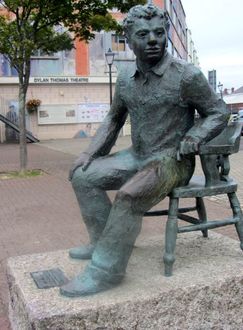
Dylan's Statue, The Maritime Quarter, Swansea
Located in the Maritime Quarter of Swansea, just a short distance from the public houses of Wind Street and the former offices of The South Wales Evening Post, where he worked for a short time as a junior reporter, can be found this striking bronze statue of Dylan Thomas.
Perched on a chair looking out over the marina in an area now named Dylan Thomas Square, which also houses the Dylan Thomas Theatre, the statue was sculpted by John Doubleday and unveiled by Lady Mary Wilson on the 21st of March, 1984.
John Doubleday, born in Essex in 1947, is a renowned artist and sculptor who studied at Goldsmiths College, University of London. He had his first ever exhibition in 1968 at The Waterhouse Gallery in London and since then has had more than thirty 'one-man' exhibitions in Britain, the Continent and America. He is best known for his figurative sculptures and aside from this figure of Dylan Thomas he has on public display sculptures of, among others, Sherlock Holmes in Baker Street and Switzerland, Lord Horatio Nelson in Gibraltar, The Beatles in Liverpool and Sir Laurence Olivier and Charlie Chaplin in London.
Located in the Maritime Quarter of Swansea, just a short distance from the public houses of Wind Street and the former offices of The South Wales Evening Post, where he worked for a short time as a junior reporter, can be found this striking bronze statue of Dylan Thomas.
Perched on a chair looking out over the marina in an area now named Dylan Thomas Square, which also houses the Dylan Thomas Theatre, the statue was sculpted by John Doubleday and unveiled by Lady Mary Wilson on the 21st of March, 1984.
John Doubleday, born in Essex in 1947, is a renowned artist and sculptor who studied at Goldsmiths College, University of London. He had his first ever exhibition in 1968 at The Waterhouse Gallery in London and since then has had more than thirty 'one-man' exhibitions in Britain, the Continent and America. He is best known for his figurative sculptures and aside from this figure of Dylan Thomas he has on public display sculptures of, among others, Sherlock Holmes in Baker Street and Switzerland, Lord Horatio Nelson in Gibraltar, The Beatles in Liverpool and Sir Laurence Olivier and Charlie Chaplin in London.
The bronze plaque, found at the base of the statue, features the closing line from the beautiful Dylan Thomas poem, 'Fern Hill'.
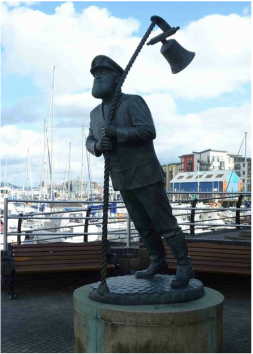
Captain Cat's Statue, The Maritime Quarter, Swansea
The statue of blind Captain Cat which stands majestically overlooking Swansea's Marina which was inspired by the lines from 'Under Milk Wood'..."Who pulls the town hall bell-rope but blind Captain Cat? One by one, the sleepers are rung out of sleep this one morning as every morning. And soon you shall see the chimneys' slow upflying snow as Captain Cat, in sailor's cap and sea-boots, announces to-day with his loud get-out-of-bed bell."
This spectacular statue was commissioned by Swansea City Council and unveiled by Councillor Tyssul Lewis on the first of March, St. David's Day, 1990. The statue itself was created by Welsh sculptor Robert Thomas and captures perfectly the spirit of Dylan Thomas's Captain Cat. A highly important character from 'Under Milk Wood', Captain Cat acts as a narrator in many scenes, observing and commenting on the characters and goings-on in the small seaside village, gazing out from the porthole shaped window of the "Seashelled, ship-in-bottled, shipshape best cabin of Schooner House",' dreaming of his long-drowned shipmates, his lost-love, Rosie Probert, and 'the clippered seas he sailed long ago when 'his eyes were blue and bright', and whose job it was to wake the town with his 'out-of-bed-Polly-put-the-kettle-on town-hall bell'.
The statue of blind Captain Cat which stands majestically overlooking Swansea's Marina which was inspired by the lines from 'Under Milk Wood'..."Who pulls the town hall bell-rope but blind Captain Cat? One by one, the sleepers are rung out of sleep this one morning as every morning. And soon you shall see the chimneys' slow upflying snow as Captain Cat, in sailor's cap and sea-boots, announces to-day with his loud get-out-of-bed bell."
This spectacular statue was commissioned by Swansea City Council and unveiled by Councillor Tyssul Lewis on the first of March, St. David's Day, 1990. The statue itself was created by Welsh sculptor Robert Thomas and captures perfectly the spirit of Dylan Thomas's Captain Cat. A highly important character from 'Under Milk Wood', Captain Cat acts as a narrator in many scenes, observing and commenting on the characters and goings-on in the small seaside village, gazing out from the porthole shaped window of the "Seashelled, ship-in-bottled, shipshape best cabin of Schooner House",' dreaming of his long-drowned shipmates, his lost-love, Rosie Probert, and 'the clippered seas he sailed long ago when 'his eyes were blue and bright', and whose job it was to wake the town with his 'out-of-bed-Polly-put-the-kettle-on town-hall bell'.
The Gower, Mumbles, Pennard, Newton and Rhossili
Rich in natural beauty and magnificent coastal scenery is the Gower peninsula. Close to Swansea, it stretches for nineteen miles and was well known to Dylan Thomas during his childhood years and adolescence. Dylan regularly travelled here for day's out or long camping holidays during the idyllic summers of his youth, the memories of which would figure heavily in his writing, particularly in the short stories found in 'Portrait Of The Artist As A Young Dog'.
As a young man he would walk the coastal paths and cliffs with his good friend Vernon Watkins, stopping at the many public houses along the way to continue their discussions about poetry. Writing about Gower in letters to his first girlfriend, Pamela Hansford-Johnson, he wrote..."It's one of the loveliest sea coast stretches in the whole of Britain", and went on to describe spending afternoons..."walking alone over the very desolate Gower cliffs, communing with the cold and the quietness".
The picturesque villages along the peninsula such as Llangennith, Bishopston, Kittle, Newton, Mewslade, Oxwich, Rhossili and Pennard were hugely important and influential in Dylan's development, not only as a person but also as a writer, but it was the stunning natural beauty of the area that had a profound effect on him, in particular in his wonderful 'Landscape' poetry.
As a young man he would walk the coastal paths and cliffs with his good friend Vernon Watkins, stopping at the many public houses along the way to continue their discussions about poetry. Writing about Gower in letters to his first girlfriend, Pamela Hansford-Johnson, he wrote..."It's one of the loveliest sea coast stretches in the whole of Britain", and went on to describe spending afternoons..."walking alone over the very desolate Gower cliffs, communing with the cold and the quietness".
The picturesque villages along the peninsula such as Llangennith, Bishopston, Kittle, Newton, Mewslade, Oxwich, Rhossili and Pennard were hugely important and influential in Dylan's development, not only as a person but also as a writer, but it was the stunning natural beauty of the area that had a profound effect on him, in particular in his wonderful 'Landscape' poetry.
The Ruins Of Pennard Castle, Overlooking Three Cliff's Bay, The Gower Peninsula
During the pre-war years, just as Dylan Thomas's career was beginning to flourish, he would often travel to the beautiful little village of Pennard to visit his friend, and fellow poet, Vernon Watkins. They would spend many hours walking the cliffs overlooking Three Cliffs Bay discussing poetry. It was here in 1931, at the ruins of Pennard Castle, that Dylan Thomas would prophetically write;
"They are rejecting me now, but the day will come when the name Dylan Thomas will be echoed from shore to shore. Only I won't be alive to hear it."
"They are rejecting me now, but the day will come when the name Dylan Thomas will be echoed from shore to shore. Only I won't be alive to hear it."
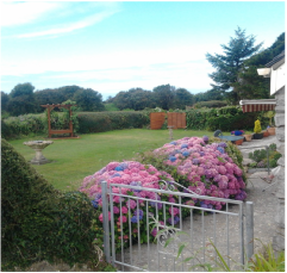
Heatherslade, Southgate Road, Pennard
The beautifully manicured lawn at Heatherslade on the cliffs at Pennard, Gower. This was the home of Vernon Watkins' parents and where they resided upon his fathers retirement. Many iconic photographs were taken here of Vernon, Dylan and Caitlin, most famously one depicting them all playing croquet.
Dylan, according to his contemporaries of the time, was always a perfect and polite guest when visiting Vernon's parents house, and would sit in the garden for hours with Vernon sipping lemonade and discussing poetry.
It was this shoreline and the Pennard cliffs that inspired Vernon's poetry, and an ever enthusiastic Vernon would take Dylan, much to his chagrin, on long walks across the cliffs to show his friend the extraordinarily beautiful landscapes.
The beautifully manicured lawn at Heatherslade on the cliffs at Pennard, Gower. This was the home of Vernon Watkins' parents and where they resided upon his fathers retirement. Many iconic photographs were taken here of Vernon, Dylan and Caitlin, most famously one depicting them all playing croquet.
Dylan, according to his contemporaries of the time, was always a perfect and polite guest when visiting Vernon's parents house, and would sit in the garden for hours with Vernon sipping lemonade and discussing poetry.
It was this shoreline and the Pennard cliffs that inspired Vernon's poetry, and an ever enthusiastic Vernon would take Dylan, much to his chagrin, on long walks across the cliffs to show his friend the extraordinarily beautiful landscapes.
The stone plaque that commemorates the friendship between Vernon Watkins and Dylan Thomas which is situated on the front wall of Heatherslade, now a Residential Home, located high on the cliffs at Pennard, Gower.
The Church of St. Mary's in the Parish of the Three Cliffs, Pennard
The memorial plaque dedicated to the memory of Vernon Watkins which can be found in the beautiful 13th Century Church of St. Mary in the Parish of the Three Cliffs, Pennard, Gower.
The words, "Death cannot steal the light which love has kindled, nor the years change it", are from the Vernon Watkins poem, 'Great Nights Returning'.
The words, "Death cannot steal the light which love has kindled, nor the years change it", are from the Vernon Watkins poem, 'Great Nights Returning'.
Vernon Watkins' Memorial Stone, Hunt's Bay, The Gower Peninsula
The Mumbles Lighthouse, Mumbles Bay
A lovely image of The Mumbles Lighthouse, which would have been an all-too-familiar sight for Dylan Thomas during his adolescent years, as he frequented The Little Theatre and Public Houses of the delightful Mumbles Bay. Dylan Thomas mentioned the Mumbles Pier and Lighthouse often in nostalgic letters to his friends when he was away from his beloved Wales and Mumbles appears often in the stories from his 1940 collection of prose, 'A Portrait Of The Artist As A Young Dog'. An example of this is when young Thomas, the reporter who appears in the biographical story, 'Old Garbo', imagines himself walking out with the barmaid from the Three Lamps public house to where;
"Couples lay loving under their coats looking out to the Mumbles Lighthouse".
"Couples lay loving under their coats looking out to the Mumbles Lighthouse".
The Antelope Public House, Oystermouth Road, Mumbles
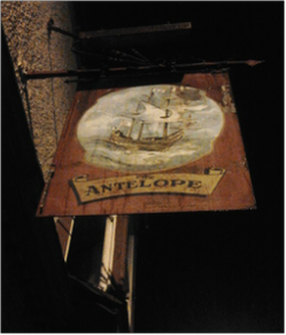
Located on the Oystermouth Road, Mumbles, on the corner of Mumbles Road and Village Lane, is The Antelope, which was a favourite public House of Dylan Thomas's during his formative years in Swansea.
Originally called The Oystermouth Castle Hotel, the name of the pub was changed in the 1860's when the then landlord, David Rees, changed the name because he had previously been the landlord of a Public House called The Antelope in the centre of Swansea and wished to retain the name. Always considered a rather 'rough' type of Public House, in 1907 The Antelope's license was under question due to accusations of disorderly and riotous conduct and newspapers in reports contemporary to the time described the establishment as, "A poor house of even poorer construction".
The Antelope was situated close to the Swansea Little Theatre where Dylan Thomas and his sister Nancy used to perform, and due to it's proximity, he was often late for rehearsals and on a couple of occasions, the actual performance itself. This led to him being dismissed by the formidable Little Theatre director, Miss Doreen Goodridge, who clashed with the young Dylan on many occasions, the last being when she told him that if he left for refreshment, probably to The Antelope, mid-performance, he would not be welcome back. Needless to say, Dylan did nip out for a quick one, and Dylan's role in the play, a translation of the French play, 'Martine', was given to another actor, despite the fact that programmes had already been printed with his name being credited.
The Antelope was taken over in the 1950's by Tim Perkins, who had known Dylan Thomas from the Kardomah Cafe days and who himself had been a minor actor at The Swansea Little Theatre.
Tim Perkins brought to The Antelope a more sophisticated ambience, which completely overshadowed it's previous bad reputation. As a particularly fine host, The Antelope attracted a new upmarket clientele, including a host of celebrities such as Anthony Hopkins, Emlyn Williams, Kenneth Williams, cricketer Garfield Sobers, Ryan Davies and Kingsley Amis.
Tim Perkins went on to become one of the founding members of the Dylan Thomas Society of Great Britain, becoming the first Chairman of this distinguished Society. The first meeting of the Society took place in Swansea on November the 9th 1977 and was attended by Dylan Thomas's daughter Aeronwy, who along with her husband Trefor Ellis presided over an evening of readings of Dylan Thomas's work.
Sadly, Tim Perkins died in 1999, but he will always be remembered for his days as licensee of The Antelope and for his dedication in preserving and promoting the work of Dylan Thomas through his work with the Dylan Thomas Society.
The Antelope was the second legendary animal in what Dylan Thomas called his 'Mythical Mumbles Pub Zoo', the first being the now long-gone Mermaid Hotel, even though clearly displayed on the outside sign that the pub was named after a ship.
Sadly, upon my last few visits, The Antelope was in a very sad state of repair, with major parts of the building being torn down. The original sign, pictured above, has disappeared, but hopefully The Antelope will rise from the ashes and become a newly refurbished establishment retaining it's historic ambience, in much the same way in which The Browns Hotel has. It deserves to be, considering the history that The Antelope Public House has in the Dylan Thomas story.
Information relating to the Public Houses frequented by Dylan Thomas in his early years in Swansea and West Wales is sourced from the marvellous Jeff Towns and Wyn Thomas publication, 'Dylan Thomas - The Pubs' published by Y Lolfa in 2013.
Originally called The Oystermouth Castle Hotel, the name of the pub was changed in the 1860's when the then landlord, David Rees, changed the name because he had previously been the landlord of a Public House called The Antelope in the centre of Swansea and wished to retain the name. Always considered a rather 'rough' type of Public House, in 1907 The Antelope's license was under question due to accusations of disorderly and riotous conduct and newspapers in reports contemporary to the time described the establishment as, "A poor house of even poorer construction".
The Antelope was situated close to the Swansea Little Theatre where Dylan Thomas and his sister Nancy used to perform, and due to it's proximity, he was often late for rehearsals and on a couple of occasions, the actual performance itself. This led to him being dismissed by the formidable Little Theatre director, Miss Doreen Goodridge, who clashed with the young Dylan on many occasions, the last being when she told him that if he left for refreshment, probably to The Antelope, mid-performance, he would not be welcome back. Needless to say, Dylan did nip out for a quick one, and Dylan's role in the play, a translation of the French play, 'Martine', was given to another actor, despite the fact that programmes had already been printed with his name being credited.
The Antelope was taken over in the 1950's by Tim Perkins, who had known Dylan Thomas from the Kardomah Cafe days and who himself had been a minor actor at The Swansea Little Theatre.
Tim Perkins brought to The Antelope a more sophisticated ambience, which completely overshadowed it's previous bad reputation. As a particularly fine host, The Antelope attracted a new upmarket clientele, including a host of celebrities such as Anthony Hopkins, Emlyn Williams, Kenneth Williams, cricketer Garfield Sobers, Ryan Davies and Kingsley Amis.
Tim Perkins went on to become one of the founding members of the Dylan Thomas Society of Great Britain, becoming the first Chairman of this distinguished Society. The first meeting of the Society took place in Swansea on November the 9th 1977 and was attended by Dylan Thomas's daughter Aeronwy, who along with her husband Trefor Ellis presided over an evening of readings of Dylan Thomas's work.
Sadly, Tim Perkins died in 1999, but he will always be remembered for his days as licensee of The Antelope and for his dedication in preserving and promoting the work of Dylan Thomas through his work with the Dylan Thomas Society.
The Antelope was the second legendary animal in what Dylan Thomas called his 'Mythical Mumbles Pub Zoo', the first being the now long-gone Mermaid Hotel, even though clearly displayed on the outside sign that the pub was named after a ship.
Sadly, upon my last few visits, The Antelope was in a very sad state of repair, with major parts of the building being torn down. The original sign, pictured above, has disappeared, but hopefully The Antelope will rise from the ashes and become a newly refurbished establishment retaining it's historic ambience, in much the same way in which The Browns Hotel has. It deserves to be, considering the history that The Antelope Public House has in the Dylan Thomas story.
Information relating to the Public Houses frequented by Dylan Thomas in his early years in Swansea and West Wales is sourced from the marvellous Jeff Towns and Wyn Thomas publication, 'Dylan Thomas - The Pubs' published by Y Lolfa in 2013.
The Paraclete Chapel, Newton Road, Mumbles
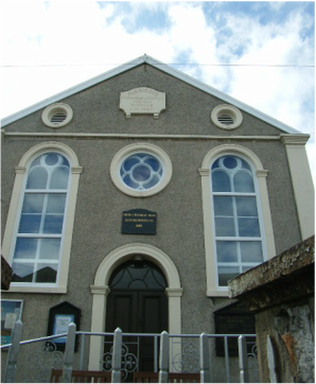
Paraclete Chapel was founded in 1816 by The Baroness Diana Barham of Kent and her Private Secretary William Hammerton, who after travelling to Gower found it to be in 'spiritual darkness and ignorance', so with the aid of certain trusts, mainly to aid the 'spiritual welfare and education of children', the Chapel was set up.
The congregation rapidly grew throughout the nineteenth century, and in 1898 the Reverend David Rees, Dylan's uncle, became the minister.
The Reverend Rees is quite an important figure in the life of Dylan Thomas for it was he that provided Vernon Watkins with Dylan' s home address in Cwmdonkin Drive and who encouraged the then unpublished poet, Vernon Watkins, to meet with his talented nephew.
The Reverend Rees also provided another enduring influence on the young Dylan, as his readings and sermons were typical of a Welsh, "Fire and Brimstone" style called 'Hwyl'. This characteristic was adopted by Dylan Thomas in his own readings and recordings and this is clear when one listens to Dylan 'booming' his verse and stories from the lectern on his various American tours or from in front of the microphone at the B.B.C.
However, although there was an obvious respect which the young Dylan Thomas had for his uncle, they were never particularly close. Even though Dylan had written a glowing account in the local paper of his uncle's career under the headline, 'End of a Great Ministry,' upon the retirement of the Reverend David Rees, in one of his early notebook poems entitled, 'The Reverend Crap,' Dylan had clearly written underneath the title his uncle's name.
Similarly, Reverend Rees had told Vernon Watkins that his nephew..."belonged in a madhouse", to which Dylan had replied, in a poem, that he..."hated his uncle, from his dandruff to his corns".
The congregation rapidly grew throughout the nineteenth century, and in 1898 the Reverend David Rees, Dylan's uncle, became the minister.
The Reverend Rees is quite an important figure in the life of Dylan Thomas for it was he that provided Vernon Watkins with Dylan' s home address in Cwmdonkin Drive and who encouraged the then unpublished poet, Vernon Watkins, to meet with his talented nephew.
The Reverend Rees also provided another enduring influence on the young Dylan, as his readings and sermons were typical of a Welsh, "Fire and Brimstone" style called 'Hwyl'. This characteristic was adopted by Dylan Thomas in his own readings and recordings and this is clear when one listens to Dylan 'booming' his verse and stories from the lectern on his various American tours or from in front of the microphone at the B.B.C.
However, although there was an obvious respect which the young Dylan Thomas had for his uncle, they were never particularly close. Even though Dylan had written a glowing account in the local paper of his uncle's career under the headline, 'End of a Great Ministry,' upon the retirement of the Reverend David Rees, in one of his early notebook poems entitled, 'The Reverend Crap,' Dylan had clearly written underneath the title his uncle's name.
Similarly, Reverend Rees had told Vernon Watkins that his nephew..."belonged in a madhouse", to which Dylan had replied, in a poem, that he..."hated his uncle, from his dandruff to his corns".
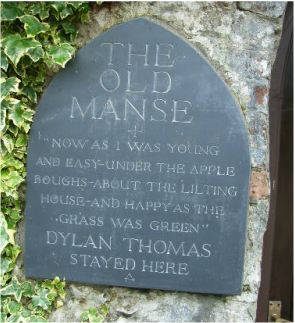
The Old Manse
The Old Manse, in the lovely little village of Newton, located near to Swansea and The Mumbles, was once the vicarage to the Paraclete Chapel.
Dylan often stayed here at weekends and summer holidays as it was the home to his Aunt Dosie, (his mother Florence's sister, Theodosia), and her husband, The Reverend David Rees.
The property is now owned by Mr. Jeff Towns, undoubtedly the world's leading authority on Dylan Thomas, chairman of The Dylan Thomas Society of Great Britain and owner of Dylan's Bookstore which is located in the grounds.
This stone plaque is located on the wall in the small passage, named Summerland Lane, just outside The Old Manse.
The Old Manse, in the lovely little village of Newton, located near to Swansea and The Mumbles, was once the vicarage to the Paraclete Chapel.
Dylan often stayed here at weekends and summer holidays as it was the home to his Aunt Dosie, (his mother Florence's sister, Theodosia), and her husband, The Reverend David Rees.
The property is now owned by Mr. Jeff Towns, undoubtedly the world's leading authority on Dylan Thomas, chairman of The Dylan Thomas Society of Great Britain and owner of Dylan's Bookstore which is located in the grounds.
This stone plaque is located on the wall in the small passage, named Summerland Lane, just outside The Old Manse.
Rhossili Bay and South Gower
Located at the very tip of the beautiful Gower Peninsula lies Rhossili Bay, a favourite holiday destination for Dylan Thomas and his friends in his teenage years and which features heavily in the short stories from 'Portrait Of The Artist As A Young Dog'.
Dylan Thomas regularly travelled here by bus from his home in Cwmdonkin Drive for short camping trips and may have even walked along the beach a few times as described in the short story, 'Who Do You Wish Was With Us?'.
This award-winning, beautiful stretch of coastline is also the backdrop for the delightful story, 'Extraordinary Little Cough', in which George Hooping sets off to run the three mile length of sands just to prove that he could.
The remote house that can be seen in the distance is known as 'The Old Rectory', and before Dylan Thomas moved to The Boathouse in Laugharne this was considered by his patrons to be an ideal place for him to live and work. However the idea was soon abandoned when Dylan himself realized how inaccessible it was and that there was no Public-House within walking distance.
Dylan Thomas regularly travelled here by bus from his home in Cwmdonkin Drive for short camping trips and may have even walked along the beach a few times as described in the short story, 'Who Do You Wish Was With Us?'.
This award-winning, beautiful stretch of coastline is also the backdrop for the delightful story, 'Extraordinary Little Cough', in which George Hooping sets off to run the three mile length of sands just to prove that he could.
The remote house that can be seen in the distance is known as 'The Old Rectory', and before Dylan Thomas moved to The Boathouse in Laugharne this was considered by his patrons to be an ideal place for him to live and work. However the idea was soon abandoned when Dylan himself realized how inaccessible it was and that there was no Public-House within walking distance.

The Worm's Head
At the southern end of Rhossili Bay lies the stunning outcrop of rock known as the Worm's Head. Possibly named from the Norse word for dragon,'wurm', the island is joined to the mainland by a rocky causeway and consists of three features known as 'The Inner Head', 'Devil's Bridge' and 'The Low Neck'.
The Worm's Head is a mile long and at its highest point reaches one hundred and fifty feet. Dylan Thomas described it as..."The great rock of The Worm's Head, at the end of the humped and serpentined body, more gulls than I had ever seen before cried over their new dead and the droppings of ages".
The Worm's Head is the final destination for the young Dylan and his friend Raymond Price, a character based on a real life friend named Trevor Hughes, in the beautifully crafted, humourous yet dark, short story, 'Who Do You Wish Was With Us?'
Dylan Thomas wrote..."Laughing on the cliff above the very long golden beach, we pointed out to each other, as though the other were blind, the great rock of The Worm's Head. The sea was out. We crossed over on slipping stones and stood, at last, triumphantly on the windy top. There was monstrous thick grass there that made us spring-heeled and we laughed and bounced on it, scaring the sheep who ran up and down the battered sides like goats. Even on this calmest day a wind blew on the worm".
The rocky causeway that links the Worm's Head to the mainland is only exposed for two and a half hours before and after low tide, Dylan Thomas, according to legend, was once trapped there overnight, after falling asleep, and recalled later...''I stayed on that Worm from dusk till midnight, sitting there on that top grass, frightened to go further in because of the rats and because of things I am ashamed to be frightened of. Then the tips of the reef began to poke out of the water and, perilously, I climbed along them to the shore".
Dylan Thomas was to return to Rhossili and the Worm's Head for one last visit in 1953, just days before his final, fateful tour of America.
At the southern end of Rhossili Bay lies the stunning outcrop of rock known as the Worm's Head. Possibly named from the Norse word for dragon,'wurm', the island is joined to the mainland by a rocky causeway and consists of three features known as 'The Inner Head', 'Devil's Bridge' and 'The Low Neck'.
The Worm's Head is a mile long and at its highest point reaches one hundred and fifty feet. Dylan Thomas described it as..."The great rock of The Worm's Head, at the end of the humped and serpentined body, more gulls than I had ever seen before cried over their new dead and the droppings of ages".
The Worm's Head is the final destination for the young Dylan and his friend Raymond Price, a character based on a real life friend named Trevor Hughes, in the beautifully crafted, humourous yet dark, short story, 'Who Do You Wish Was With Us?'
Dylan Thomas wrote..."Laughing on the cliff above the very long golden beach, we pointed out to each other, as though the other were blind, the great rock of The Worm's Head. The sea was out. We crossed over on slipping stones and stood, at last, triumphantly on the windy top. There was monstrous thick grass there that made us spring-heeled and we laughed and bounced on it, scaring the sheep who ran up and down the battered sides like goats. Even on this calmest day a wind blew on the worm".
The rocky causeway that links the Worm's Head to the mainland is only exposed for two and a half hours before and after low tide, Dylan Thomas, according to legend, was once trapped there overnight, after falling asleep, and recalled later...''I stayed on that Worm from dusk till midnight, sitting there on that top grass, frightened to go further in because of the rats and because of things I am ashamed to be frightened of. Then the tips of the reef began to poke out of the water and, perilously, I climbed along them to the shore".
Dylan Thomas was to return to Rhossili and the Worm's Head for one last visit in 1953, just days before his final, fateful tour of America.
Dylan Thomas's West Wales and Carmarthenshire
Fern Hill Farm, Llangain, Carmarthenshire, West Wales
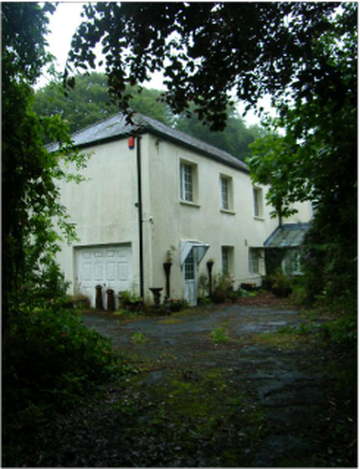
Fern Hill Farm, Llangain, as it appears today, sadly unappreciated, neglected and unloved.
The inspiration behind Dylan Thomas's most beautiful and beloved poem, Fern Hill lies deep in the Welsh countryside, hidden down a winding leafy lane between the villages of Llangain and Llansteffan. This was where Dylan Thomas spent his childhood holidays, staying with his mother's elder sister, Aunt Annie and her husband Jim Jones.
According to local legend, the house had previously been occupied by the public hangman of Carmarthen, a man named Evans, who discovered that his only daughter, who he kept imprisoned in a tiny room with no windows, had escaped and eloped with a local boy, and had, in his grief, ironically hanged himself in the parlour.
But to Dylan Thomas, Fern Hill would always be a place of long-lost days of exploration and nostalgia, as he said himself;
"The farm was a place... that I have come to associate with all the golden summers of my childhood".
The poem, as it stands, is as he wanted it to be;
'A joyous celebration of childhood innocence and inevitable loss,' Fern Hill was a poem which Dylan Thomas himself described as being intended for 'Evening and Tears'.
At the stage in his life when Dylan Thomas wrote Fern Hill, both Aunt Annie and Uncle Jim were long dead and Fern Hill had been abandoned to its 'nettles and owls'. The poem, it has been said, comes across as a 'Poem without people', just the young boy Dylan alone with the house, the animals and the countryside.
Fern Hill is also the setting for the farm in the delightful short story 'The Peaches', from 'Portrait Of The Artist As A Young Dog', although the farm's name had been changed to Gorse Hill. The front parlour of the farm is also featured in the moving poem, 'After The Funeral, In Memory Of Ann Jones'.
The inspiration behind Dylan Thomas's most beautiful and beloved poem, Fern Hill lies deep in the Welsh countryside, hidden down a winding leafy lane between the villages of Llangain and Llansteffan. This was where Dylan Thomas spent his childhood holidays, staying with his mother's elder sister, Aunt Annie and her husband Jim Jones.
According to local legend, the house had previously been occupied by the public hangman of Carmarthen, a man named Evans, who discovered that his only daughter, who he kept imprisoned in a tiny room with no windows, had escaped and eloped with a local boy, and had, in his grief, ironically hanged himself in the parlour.
But to Dylan Thomas, Fern Hill would always be a place of long-lost days of exploration and nostalgia, as he said himself;
"The farm was a place... that I have come to associate with all the golden summers of my childhood".
The poem, as it stands, is as he wanted it to be;
'A joyous celebration of childhood innocence and inevitable loss,' Fern Hill was a poem which Dylan Thomas himself described as being intended for 'Evening and Tears'.
At the stage in his life when Dylan Thomas wrote Fern Hill, both Aunt Annie and Uncle Jim were long dead and Fern Hill had been abandoned to its 'nettles and owls'. The poem, it has been said, comes across as a 'Poem without people', just the young boy Dylan alone with the house, the animals and the countryside.
Fern Hill is also the setting for the farm in the delightful short story 'The Peaches', from 'Portrait Of The Artist As A Young Dog', although the farm's name had been changed to Gorse Hill. The front parlour of the farm is also featured in the moving poem, 'After The Funeral, In Memory Of Ann Jones'.
The Boar's Head Hotel, Carmarthen, Carmarthenshire
Dylan Thomas's Laugharne, West Wales
"The strangest town in Wales" as Dylan Thomas called it, Laugharne is located in Carmarthenshire, in the rural west of Wales.
Laying on the estuary of the River Taf, the town was originally known as Abercorran but was renamed after the English Civil War in honour of a local army officer, Major-General Rowland Laugharne, who had heroically commanded the Parliamentarian army in 1648.
Laugharne is famous as being one of the last surviving townships to be run by a Corporation, (the other being The City Of London), the township being established in 1291 by Sir Guy De Brian. Nowadays largely ceremonial, the Corporation is presided over by a Portreeve, (the equivalent official status as a Mayor), an Aldermen and a specially selected group of Burgesses.
Fishing and the cockle industry were once a significant part of the Laugharne economy and the famous Welsh pickling firm of Parsons began in the town.
Consisting of an array of fine Georgian houses, most notably Castle House and Great House, the town also has a magnificent Town Hall and its own 12th century castle. Laugharne is also home to probably the best known literary public house, Brown's Hotel, as well as Corran Books, which is owned by both Dylan and Caitlin Thomas biographer, George Tremlett.
Aside from Dylan Thomas many other famous literary figures are associated with Laugharne. Mary Wollstonecraft and her equally famous daughter Mary Shelley, author of 'Frankenstein', resided there for a while, as have poet Walter Savage Landor, Samuel Taylor Coleridge, War poet Edward Thomas and writer Richard Hughes, author of 'A High Wind In Jamaica'. More recently writers such as Kingsley Amis, Lynette Roberts and Margaret Atwood have, at one time or another, lived in this beguiling town.
Dylan Thomas first visited Laugharne on the afternoon of the 21st of May, 1934 and immediately fell in love with the small town. In total, Dylan Thomas would live at three addresses in Laugharne, the first being a small damp cottage named Eros located in Gosport Street, followed by a move to the much more luxurious Seaview and finally in 1949 to the Boathouse. Dylan Thomas's first official biographer Constantine Fitzgibbon wrote that Laugharne..."fitted Dylan like a single, eccentric, tattered glove", while Dylan Thomas's close friend Vernon Watkins, wrote that..."The peace and beauty of this small sea-town, a fishing village at the end of the world, represented for him the last refuge of life and sanity in a nightmare world".
In one of his radio broadcasts, simply entitled 'Laugharne', Dylan described the town saying... "This timeless, beautiful, barmy, (both spellings), town...a legendary lazy little black-magical bedlam by the sea".
Ironically it was during the broadcast of this piece, to a large audience, which included Caitlin, in Laugharne Town Hall, that the local policeman handed the telegram to Caitlin which informed her that Dylan was seriously ill in hospital in New York.
The Town Hall in the foreground would have been passed by Dylan Thomas on a daily basis during his time in Laugharne as it stands majestically on the corner of the high street on Dylan's journey from the Boathouse to Brown's Hotel and his parent's house. Dylan once wrote to Margaret Taylor, Dylan's patron and provider of the Boathouse, that... 'It's clock tells the time backwards'.
Laying on the estuary of the River Taf, the town was originally known as Abercorran but was renamed after the English Civil War in honour of a local army officer, Major-General Rowland Laugharne, who had heroically commanded the Parliamentarian army in 1648.
Laugharne is famous as being one of the last surviving townships to be run by a Corporation, (the other being The City Of London), the township being established in 1291 by Sir Guy De Brian. Nowadays largely ceremonial, the Corporation is presided over by a Portreeve, (the equivalent official status as a Mayor), an Aldermen and a specially selected group of Burgesses.
Fishing and the cockle industry were once a significant part of the Laugharne economy and the famous Welsh pickling firm of Parsons began in the town.
Consisting of an array of fine Georgian houses, most notably Castle House and Great House, the town also has a magnificent Town Hall and its own 12th century castle. Laugharne is also home to probably the best known literary public house, Brown's Hotel, as well as Corran Books, which is owned by both Dylan and Caitlin Thomas biographer, George Tremlett.
Aside from Dylan Thomas many other famous literary figures are associated with Laugharne. Mary Wollstonecraft and her equally famous daughter Mary Shelley, author of 'Frankenstein', resided there for a while, as have poet Walter Savage Landor, Samuel Taylor Coleridge, War poet Edward Thomas and writer Richard Hughes, author of 'A High Wind In Jamaica'. More recently writers such as Kingsley Amis, Lynette Roberts and Margaret Atwood have, at one time or another, lived in this beguiling town.
Dylan Thomas first visited Laugharne on the afternoon of the 21st of May, 1934 and immediately fell in love with the small town. In total, Dylan Thomas would live at three addresses in Laugharne, the first being a small damp cottage named Eros located in Gosport Street, followed by a move to the much more luxurious Seaview and finally in 1949 to the Boathouse. Dylan Thomas's first official biographer Constantine Fitzgibbon wrote that Laugharne..."fitted Dylan like a single, eccentric, tattered glove", while Dylan Thomas's close friend Vernon Watkins, wrote that..."The peace and beauty of this small sea-town, a fishing village at the end of the world, represented for him the last refuge of life and sanity in a nightmare world".
In one of his radio broadcasts, simply entitled 'Laugharne', Dylan described the town saying... "This timeless, beautiful, barmy, (both spellings), town...a legendary lazy little black-magical bedlam by the sea".
Ironically it was during the broadcast of this piece, to a large audience, which included Caitlin, in Laugharne Town Hall, that the local policeman handed the telegram to Caitlin which informed her that Dylan was seriously ill in hospital in New York.
The Town Hall in the foreground would have been passed by Dylan Thomas on a daily basis during his time in Laugharne as it stands majestically on the corner of the high street on Dylan's journey from the Boathouse to Brown's Hotel and his parent's house. Dylan once wrote to Margaret Taylor, Dylan's patron and provider of the Boathouse, that... 'It's clock tells the time backwards'.
Eros, Gosport Street, Laugharne, West Wales
A contemporary photograph, captured in 2016, of the first proper home in Laugharne of Dylan and Caitlin Thomas, the rather over grandly-named 'Eros', located in Gosport Street, in the lower part of the town. At the time of their occupation, a move secured for them by the writer Richard Hughes, 'Eros' was a dark, damp and dingy two-bedroomed fisherman's cottage, with no bathroom or running water and just an outside toilet. It had a long narrow garden to the rear of the house which led down to the Taf Estuary, where Dylan would watch the 'Webfoot cocklewomen' gathering in the cockles at low tide. Dylan and Caitlin were to live at 'Eros' for just a few short months before moving to the more spacious and comfortable 'Seaview' towards the centre of the town.
'Seaview' Market Lane, Laugharne, West Wales
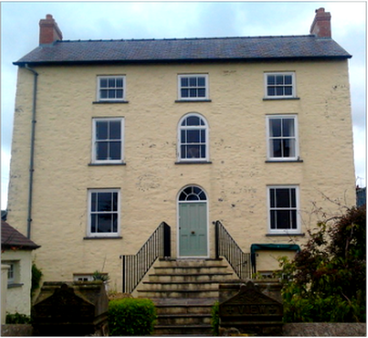
Early in 1938, Dylan and Caitlin Thomas were firmly ensconced in Laugharne and living in Gosport Street in a rather cramped, dingy and dilapidated fisherman's cottage called 'Eros', a tired two-roomed building with no bathroom and just an outside toilet. It was rather a stressful time for the Thomas's but by early July that year their fortunes had changed.
Thanks to Tudor Williams, the owner of 'Seaview' and the brother of Ebie Williams, the landlord of Brown's Hotel, the Thomas's were able to rent, at the cost of seven shillings and sixpence a month, this much grander property in Laugharne, Seaview.
This impressive four-storey property with the deceptive name 'Seaview', (the estuary could only be seen from one window on the top floor), was, in Dylan Thomas's words.." A tall and dignified house at the posh end of this small town". Broad, tall and symmetrical, but only one room deep, 'Seaview' resembles an early Victorian doll's house and was in Augustus John's words, who was a regular visitor during their tenancy, "A strange house with a certain air of mystery about it".
Although unfurnished at the time the Thomas's moved in, (a situation soon remedied by family and friends), and with no electricity or running water, according to Vernon Watkins the two years in which the Thomas's lived in Seaview were the happiest of Dylan and Caitlin's life together.
The Thomas's soon settled into a life of routine domesticity; Dylan was writing, Caitlin cooked and cleaned and always had one of her famous stews bubbling on the wood-burning stove, and in the evenings, by the flickering light of candles in beer bottles, Dylan would read while Caitlin would paint.
Dylan and Caitlin Thomas would remain at Seaview for exactly two years, before moving just for a short while to London, in July, 1940.
Thanks to Tudor Williams, the owner of 'Seaview' and the brother of Ebie Williams, the landlord of Brown's Hotel, the Thomas's were able to rent, at the cost of seven shillings and sixpence a month, this much grander property in Laugharne, Seaview.
This impressive four-storey property with the deceptive name 'Seaview', (the estuary could only be seen from one window on the top floor), was, in Dylan Thomas's words.." A tall and dignified house at the posh end of this small town". Broad, tall and symmetrical, but only one room deep, 'Seaview' resembles an early Victorian doll's house and was in Augustus John's words, who was a regular visitor during their tenancy, "A strange house with a certain air of mystery about it".
Although unfurnished at the time the Thomas's moved in, (a situation soon remedied by family and friends), and with no electricity or running water, according to Vernon Watkins the two years in which the Thomas's lived in Seaview were the happiest of Dylan and Caitlin's life together.
The Thomas's soon settled into a life of routine domesticity; Dylan was writing, Caitlin cooked and cleaned and always had one of her famous stews bubbling on the wood-burning stove, and in the evenings, by the flickering light of candles in beer bottles, Dylan would read while Caitlin would paint.
Dylan and Caitlin Thomas would remain at Seaview for exactly two years, before moving just for a short while to London, in July, 1940.
The plaque which graces the wall outside 'Seaview', commemorating the two years Dylan Thomas lived in the house.
Brown's Hotel, King Street, Laugharne, West Wales
Brown's Hotel, the largest and grandest property located on King Street, Laugharne, is the Public House most associated with Dylan Thomas.
It was originally built as a private house in 1752 but became a hotel in the mid 1800's. During the time in which Dylan Thomas lived in Laugharne it was owned by Ivy Williams and her husband Ebie, who also owned the local bus depot as well as 'Sea View', Dylan Thomas's second house during his time in Laugharne, and 'Pelican', located opposite Brown's Hotel, which Dylan Thomas rented for his mother and father.
Ivy Williams and Dylan Thomas became good friends, and would often be found in the window seat together, playing cards and exchanging the local gossip. Dylan Thomas had a strict routine during his time in Laugharne and would always call at Brown's Hotel in the morning with his father for a Guinness, after completing 'The Times crossword together across the road at 'Pelican'. At six o'clock, after an afternoon working in the writing shed above the Boathouse, he and Caitlin would return to Brown's Hotel where they would both remain until, and sometimes long after, closing time.
Dylan Thomas's wake was held at Brown's Hotel in 1953, as was Caitlin's when she was brought home to Laugharne in 1994 to be buried alongside her famous husband.
It was originally built as a private house in 1752 but became a hotel in the mid 1800's. During the time in which Dylan Thomas lived in Laugharne it was owned by Ivy Williams and her husband Ebie, who also owned the local bus depot as well as 'Sea View', Dylan Thomas's second house during his time in Laugharne, and 'Pelican', located opposite Brown's Hotel, which Dylan Thomas rented for his mother and father.
Ivy Williams and Dylan Thomas became good friends, and would often be found in the window seat together, playing cards and exchanging the local gossip. Dylan Thomas had a strict routine during his time in Laugharne and would always call at Brown's Hotel in the morning with his father for a Guinness, after completing 'The Times crossword together across the road at 'Pelican'. At six o'clock, after an afternoon working in the writing shed above the Boathouse, he and Caitlin would return to Brown's Hotel where they would both remain until, and sometimes long after, closing time.
Dylan Thomas's wake was held at Brown's Hotel in 1953, as was Caitlin's when she was brought home to Laugharne in 1994 to be buried alongside her famous husband.
'Pelican' King Street, Laugharne, West Wales
Located on King Street, just across the road from Brown's Hotel, is the rather grand Georgian terraced house named 'Pelican'. Dylan Thomas's parents, D.J. and Florence resided here from early May, 1949.
It was Dylan Thomas himself who secured them the property, renting 'Pelican' from Ebie Williams, who at that time was the landlord of Brown's Hotel.
The building itself was originally built around 1800 and was, ironically, originally a public house up until the early 1900's. Dylan Thomas would visit here every day when he was living in Laugharne to chat to his mother and to do 'The Times' crossword with his father before adjourning to Brown's Hotel for lunchtime drinks, a daily routine which usually involved a few games of cards and a gossip about the local inhabitants, or tales of London and America with the landlady, Ivy Williams.
Dylan Thomas left Laugharne for his final, fateful trip to America from 'The Pelican' on the morning of the 9th of October, 1953, turning back three times to kiss his mother goodbye, as if he had a premonition that he would never see her again.
Dylan Thomas would return to this house just once more, on view in the front room of 'Pelican' in an open coffin on the morning of his funeral.
It was Dylan Thomas himself who secured them the property, renting 'Pelican' from Ebie Williams, who at that time was the landlord of Brown's Hotel.
The building itself was originally built around 1800 and was, ironically, originally a public house up until the early 1900's. Dylan Thomas would visit here every day when he was living in Laugharne to chat to his mother and to do 'The Times' crossword with his father before adjourning to Brown's Hotel for lunchtime drinks, a daily routine which usually involved a few games of cards and a gossip about the local inhabitants, or tales of London and America with the landlady, Ivy Williams.
Dylan Thomas left Laugharne for his final, fateful trip to America from 'The Pelican' on the morning of the 9th of October, 1953, turning back three times to kiss his mother goodbye, as if he had a premonition that he would never see her again.
Dylan Thomas would return to this house just once more, on view in the front room of 'Pelican' in an open coffin on the morning of his funeral.
The original 'Pelican' name-plaque which used to be positioned on the front wall beside the front door of 'Pelican' during the time of Dylan Thomas's parents occupancy in Laugharne. Sadly, since 2013, the plaque is no longer on display.
The Cross House Inn, The Grist, Lower Town Laugharne, West Wales
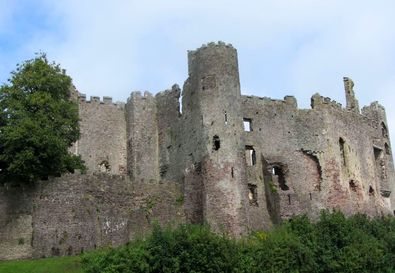
Laugharne Castle
Dominating the magnificent Laugharne skyline is the majesty of Laugharne Castle, described by Dylan Thomas in 'Poem In October' as being "The castle, brown as owls".
The original castle was built in 1116 and was originally occupied by Robert Courtemain, who entrusted it's care to the Welshman Bleddyn ap Cedifor. Laugharne Castle was the setting for a treaty of peace between Henry II and Rhys ap Gruffudd in 1172, but when Henry died in 1189 the original castle was seized and probably burnt down. The castle was rebuilt by the Normans in 1215 but was back in Welsh hands soon after, when it was captured by Llewlyn The Great.
In 1584 Elizabeth I gifted the castle to Sir John Perrott, who was at that time rumoured to be an illegitimate son of her father, Henry VIII.
During the Civil War the castle was seized by Parliamentarian forces, led by Major-General Rowland Laugharne, the man responsible for giving the former town of Abercorran it's now famous name. Due to heavy cannon fire the castle was left in a semi-ruined state and it remained so until well into the 1800's. It was only during the early 1900's that the castle was partially restored and the gardens landscaped to their now magnificent grandeur.
Dominating the magnificent Laugharne skyline is the majesty of Laugharne Castle, described by Dylan Thomas in 'Poem In October' as being "The castle, brown as owls".
The original castle was built in 1116 and was originally occupied by Robert Courtemain, who entrusted it's care to the Welshman Bleddyn ap Cedifor. Laugharne Castle was the setting for a treaty of peace between Henry II and Rhys ap Gruffudd in 1172, but when Henry died in 1189 the original castle was seized and probably burnt down. The castle was rebuilt by the Normans in 1215 but was back in Welsh hands soon after, when it was captured by Llewlyn The Great.
In 1584 Elizabeth I gifted the castle to Sir John Perrott, who was at that time rumoured to be an illegitimate son of her father, Henry VIII.
During the Civil War the castle was seized by Parliamentarian forces, led by Major-General Rowland Laugharne, the man responsible for giving the former town of Abercorran it's now famous name. Due to heavy cannon fire the castle was left in a semi-ruined state and it remained so until well into the 1800's. It was only during the early 1900's that the castle was partially restored and the gardens landscaped to their now magnificent grandeur.
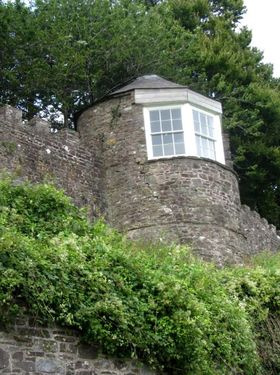
The Gazebo, Laugharne Castle
Constructed in the early nineteenth century, the Gazebo was built onto the base of one of the estuary-facing towers located in the grounds of the magnificent Laugharne Castle.
Completed in 1830, the Gazebo was a prominent feature of the gardens attached to Castle House, which were later to be owned by the novelist Richard Hughes.
Hughes, author of the highly successful novel 'A High Wind In Jamaica', befriended Dylan Thomas in 1934 during Dylan's early visits to Laugharne and as Caitlin Thomas was heavily pregnant at that time with their first child Llewelyn, he invited the couple to stay with him in the relative comfort of Castle House.
Dylan Thomas had already, in those early years, fallen in love with Laugharne and had decided that this was the place in which he would most like to settle.
Dylan Thomas, as he did with most of the people who befriended him, took full advantage of Richard Hughes' s hospitality and rooted himself high in the Gazebo to write, and to also enjoy bottles of expensive wine pilfered from the wine-cellar owned by the unsuspecting Hughes.
The Gazebo, most importantly, provided Dylan Thomas with spectacular views of the estuary, a view he always seemed to require when working on his 'Landscape' poetry. (The writing shed at the Boathouse would provide him with the same inspiration in later years).
It was here at the Gazebo that Dylan would write most of the pieces that were to make up the collection of short stories that would become his most famous prose work, 'Portrait Of The Artist As A Young Dog'.
Dylan wrote to Vernon Watkins often during his time staying at Richard Hughes' expense and, in mentioning the Gazebo, Dylan wrote..."I have the romantic, dirty summerhouse looking over the marsh to write in...and Caitlin, an almost empty, large room to dance in".
Constructed in the early nineteenth century, the Gazebo was built onto the base of one of the estuary-facing towers located in the grounds of the magnificent Laugharne Castle.
Completed in 1830, the Gazebo was a prominent feature of the gardens attached to Castle House, which were later to be owned by the novelist Richard Hughes.
Hughes, author of the highly successful novel 'A High Wind In Jamaica', befriended Dylan Thomas in 1934 during Dylan's early visits to Laugharne and as Caitlin Thomas was heavily pregnant at that time with their first child Llewelyn, he invited the couple to stay with him in the relative comfort of Castle House.
Dylan Thomas had already, in those early years, fallen in love with Laugharne and had decided that this was the place in which he would most like to settle.
Dylan Thomas, as he did with most of the people who befriended him, took full advantage of Richard Hughes' s hospitality and rooted himself high in the Gazebo to write, and to also enjoy bottles of expensive wine pilfered from the wine-cellar owned by the unsuspecting Hughes.
The Gazebo, most importantly, provided Dylan Thomas with spectacular views of the estuary, a view he always seemed to require when working on his 'Landscape' poetry. (The writing shed at the Boathouse would provide him with the same inspiration in later years).
It was here at the Gazebo that Dylan would write most of the pieces that were to make up the collection of short stories that would become his most famous prose work, 'Portrait Of The Artist As A Young Dog'.
Dylan wrote to Vernon Watkins often during his time staying at Richard Hughes' expense and, in mentioning the Gazebo, Dylan wrote..."I have the romantic, dirty summerhouse looking over the marsh to write in...and Caitlin, an almost empty, large room to dance in".
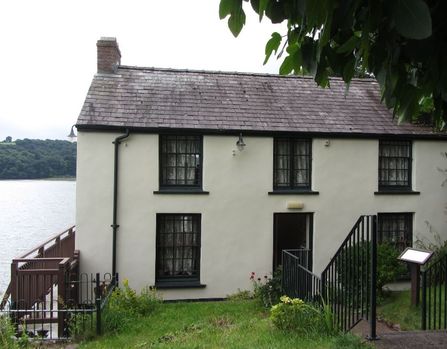
The Boathouse, Dylan's Walk, Laugharne
The building most closely associated with Dylan Thomas is, of course, the Boathouse. Located in the sleepy Welsh town of Laugharne, "The strangest town in Wales..." as Dylan Thomas called it.
The lease for the Boathouse was paid for by Dylan Thomas's most enthusiastic patron, Margaret Taylor, the wife of historian A.J.P. Taylor, in 1949.
The origin of the Boathouse is unclear, it is highly possible it was so named because boats were moored alongside the estuary wall or possibly because there used to be a small building which repaired boats located close by. What is known however, is that records show it was first leased by The Laugharne Corporation to a local family in 1834, before being converted into two separate fisherman's cottages, only to be restored back to a single dwelling in 1899.
Prior to the Thomas family moving here, the Boathouse was a holiday home for a Worcestershire doctor and the writing shed was a garage for the doctors Wolsey, at one time the only car in Laugharne.
Local inhabitants of Laugharne still tell of stories associated with smuggling at the Boathouse as it was discovered that there was in fact a secret entrance located near to the front door which led down to the water's edge.
Dylan Thomas moved into this, "Seashaken house on a breakneck of rocks" in May of 1949, along with a heavily pregnant Caitlin and their children, son Llewelyn and daughter Aeronwy. At the time of their occupancy, the Boathouse had no electricity or running water and was a haven for rats, of which Dylan Thomas was particularly afraid.
Dylan Thomas wrote of the Boathouse often, and in a letter to one of his numerous patrons, in November 1952, described it as;
"A tumbling house whose every broken pane and wind whipped-off slate, childscrawled wall, rain-stain, mousehole, knobble and ricket, man-booby-and-rat-trap, I know in my sleep..."
The Boathouse was to be Dylan Thomas's home from May 1949 until the 9th October 1953 when he left Laugharne for the last time to commence on his fourth and final reading tour of America. After Dylan Thomas's death the house was home to Caitlin and their three children, until she found that the memory of Dylan was too much for her to bear and she left a few weeks after Dylan's funeral to live in Elba. Florence Thomas, Dylan's widowed mother, then lived at the Boathouse until her death in August 1958.
The building most closely associated with Dylan Thomas is, of course, the Boathouse. Located in the sleepy Welsh town of Laugharne, "The strangest town in Wales..." as Dylan Thomas called it.
The lease for the Boathouse was paid for by Dylan Thomas's most enthusiastic patron, Margaret Taylor, the wife of historian A.J.P. Taylor, in 1949.
The origin of the Boathouse is unclear, it is highly possible it was so named because boats were moored alongside the estuary wall or possibly because there used to be a small building which repaired boats located close by. What is known however, is that records show it was first leased by The Laugharne Corporation to a local family in 1834, before being converted into two separate fisherman's cottages, only to be restored back to a single dwelling in 1899.
Prior to the Thomas family moving here, the Boathouse was a holiday home for a Worcestershire doctor and the writing shed was a garage for the doctors Wolsey, at one time the only car in Laugharne.
Local inhabitants of Laugharne still tell of stories associated with smuggling at the Boathouse as it was discovered that there was in fact a secret entrance located near to the front door which led down to the water's edge.
Dylan Thomas moved into this, "Seashaken house on a breakneck of rocks" in May of 1949, along with a heavily pregnant Caitlin and their children, son Llewelyn and daughter Aeronwy. At the time of their occupancy, the Boathouse had no electricity or running water and was a haven for rats, of which Dylan Thomas was particularly afraid.
Dylan Thomas wrote of the Boathouse often, and in a letter to one of his numerous patrons, in November 1952, described it as;
"A tumbling house whose every broken pane and wind whipped-off slate, childscrawled wall, rain-stain, mousehole, knobble and ricket, man-booby-and-rat-trap, I know in my sleep..."
The Boathouse was to be Dylan Thomas's home from May 1949 until the 9th October 1953 when he left Laugharne for the last time to commence on his fourth and final reading tour of America. After Dylan Thomas's death the house was home to Caitlin and their three children, until she found that the memory of Dylan was too much for her to bear and she left a few weeks after Dylan's funeral to live in Elba. Florence Thomas, Dylan's widowed mother, then lived at the Boathouse until her death in August 1958.
Dylan Thomas's Death-Mask Sculptured By David Slivka, Owned By Richard Burton.
Proudly on display in the Dylan Thomas Boathouse is this copy of the David Slivka cast of Dylan Thomas's death-mask, the third of five which are still remaining in Wales. This copy was a personal gift to Richard Burton in 1954 by the sculptor himself and remained in Richard Burton's safekeeping at his homes, firstly at the Casa Kimberly in Mexico and then in Celigny, Switzerland until his death in 1984. The death-mask was donated to the Boathouse by Sally Burton following Richard Burton's death in the August of 1984.
Coins And Cuff-Links Owned By Dylan Thomas
The historic and stunningly beautiful Boathouse, located on the Taf Estuary, Laugharne, captured in the sunshine of an August afternoon in 2017.

The Boathouse Writing Shed, Laugharne
The interior of Dylan Thomas's writing shed, which is now located on the cliff path above The Boathouse, renamed 'Dylan's Walk'.
After undergoing extensive restoration, the shed now appears as it would have when Dylan Thomas spent his days here, complete with pieces of furniture which were previously owned by the Thomas family and moved here from 'Pelican'.
It was from here, inspired by the magnificent and unspoilt views from the window overlooking the Taf estuary, that Dylan Thomas wrote some of his most moving 'Landscape' poetry. The first poem inspired by the breathtaking scenery here, of the sandbanks, cormorants and herons, was 'Over Sir John's Hill', and this was followed by 'In the White Giant's Thigh', 'In Country Heaven' and 'Poem On His Birthday', in which he describes his writing-shed as..." the long tongued room" and " his slant, racking house".
It was also here in the writing shed that Dylan Thomas wrote two of his most poignant poems, both dedicated to his father, the haunting, 'Do Not Go Gentle Into That Good Night' and 'Elegy'.
The first drafts of 'Under Milk Wood', probably his most famous work, his 'Play For Voices' set in a caricatural Welsh village, based on Laugharne, were also written here.
John Malcolm Brinnin, writing in his controversial book 'Dylan Thomas In America', described the writing shed as...
'' A rat's nest of chewed, rolled and discarded papers - piles of manuscripts, unanswered (often unopened ) letters, empty cigarette packages, small stacks of literary periodicals, tradesmen's bills and publishers brochures. Snatches of poetry lay under empty beer bottles. Volumes of poetry mouldered where they had been placed months, years before. Besides a single table and two straight-backed chairs, the studio contained three or four half-filled cartons of books".
The interior of Dylan Thomas's writing shed, which is now located on the cliff path above The Boathouse, renamed 'Dylan's Walk'.
After undergoing extensive restoration, the shed now appears as it would have when Dylan Thomas spent his days here, complete with pieces of furniture which were previously owned by the Thomas family and moved here from 'Pelican'.
It was from here, inspired by the magnificent and unspoilt views from the window overlooking the Taf estuary, that Dylan Thomas wrote some of his most moving 'Landscape' poetry. The first poem inspired by the breathtaking scenery here, of the sandbanks, cormorants and herons, was 'Over Sir John's Hill', and this was followed by 'In the White Giant's Thigh', 'In Country Heaven' and 'Poem On His Birthday', in which he describes his writing-shed as..." the long tongued room" and " his slant, racking house".
It was also here in the writing shed that Dylan Thomas wrote two of his most poignant poems, both dedicated to his father, the haunting, 'Do Not Go Gentle Into That Good Night' and 'Elegy'.
The first drafts of 'Under Milk Wood', probably his most famous work, his 'Play For Voices' set in a caricatural Welsh village, based on Laugharne, were also written here.
John Malcolm Brinnin, writing in his controversial book 'Dylan Thomas In America', described the writing shed as...
'' A rat's nest of chewed, rolled and discarded papers - piles of manuscripts, unanswered (often unopened ) letters, empty cigarette packages, small stacks of literary periodicals, tradesmen's bills and publishers brochures. Snatches of poetry lay under empty beer bottles. Volumes of poetry mouldered where they had been placed months, years before. Besides a single table and two straight-backed chairs, the studio contained three or four half-filled cartons of books".
The exterior to the replica of Dylan Thomas's writing shed which now stands on the pathway known as 'Dylan's Walk', located just above the Boathouse. The original doors to the writing shed are now housed in the Dylan Thomas Centre, Swansea.
The Parish Church of St. Martin of Tours, Laugharne, West Wales
St. Martin's Church and Churchyard, Laugharne, West Wales, as photographed in 2014 and 2017
The Memorial Plaque to the memory of Dylan Thomas which adorns the wall of St. Martin's Church, Laugharne. The plaque is nearly an exact replica of the Memorial Stone which can be found in Poet's Corner at Westminster Abbey, which was unveiled on the 1st March, 1982. The Memorial Plaque in St. Martin's Church, as the Memorial Stone in Westminster Abbey, is made from Penrhyn stone and was sculpted by artist Jonah Jones.
The Grave of Dylan Thomas, St. Martin's Churchyard, Laugharne, West Wales
The simple white wooden cross which graces Dylan Thomas's final resting place in the beautiful and tranquil surroundings of St. Martin's Churchyard, Laugharne.
Dylan Thomas was laid to rest here on the 24th of November, 1953 with Caitlin Thomas buried alongside her former husband following her own death, so many years later, aged eighty, in 1994.
In this small secondary graveyard, which is reached by crossing a small bridge to the right of St. Martin's Church's beautiful yew lined grounds, through the lychgate and surrounded by ornate granite, stone and marble gravestones and memorials, stands, nearly central, this plain simple white wooden cross, which appears so more poignant and moving in it's simplicity.
St. Martin's Church is in itself a wonderful and fine example of Welsh Gothic architecture. Built in the fourteenth century and restored in the fifteenth and again in 1873, it is also home to The Laugharne Cross. Dating from the ninth or tenth century, it is a cross of oddly shaped Celtic design which has been built into the east wing of the South Transept.
Dylan Thomas was laid to rest here on the 24th of November, 1953 with Caitlin Thomas buried alongside her former husband following her own death, so many years later, aged eighty, in 1994.
In this small secondary graveyard, which is reached by crossing a small bridge to the right of St. Martin's Church's beautiful yew lined grounds, through the lychgate and surrounded by ornate granite, stone and marble gravestones and memorials, stands, nearly central, this plain simple white wooden cross, which appears so more poignant and moving in it's simplicity.
St. Martin's Church is in itself a wonderful and fine example of Welsh Gothic architecture. Built in the fourteenth century and restored in the fifteenth and again in 1873, it is also home to The Laugharne Cross. Dating from the ninth or tenth century, it is a cross of oddly shaped Celtic design which has been built into the east wing of the South Transept.
Caitlin Thomas's name as it appears on the reverse of Dylan Thomas's simple wooden white grave-marker.
This page was updated on the 31st of May, 2021
